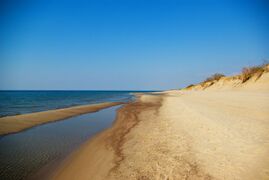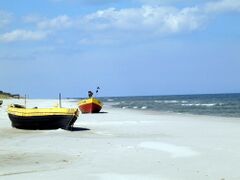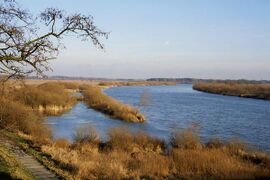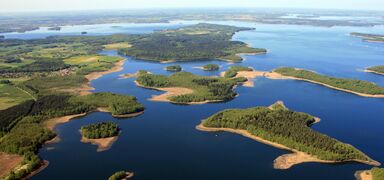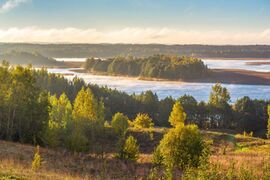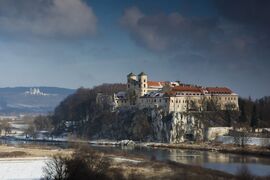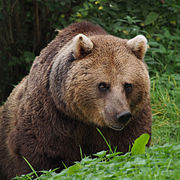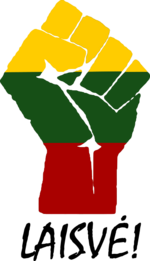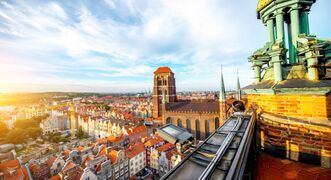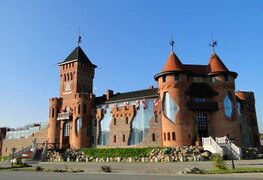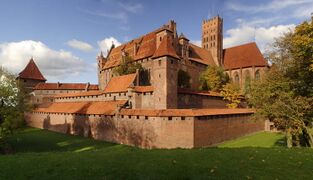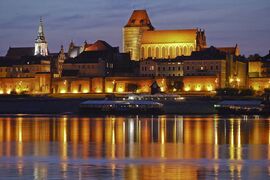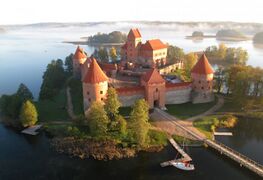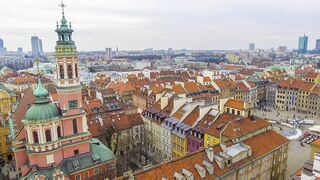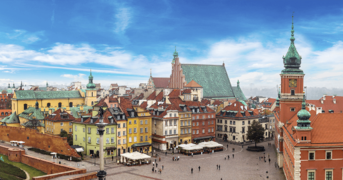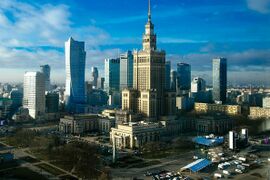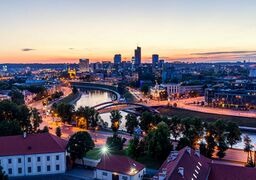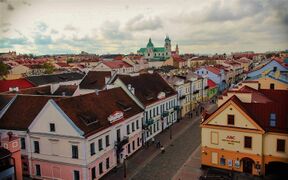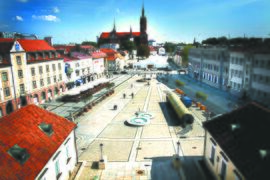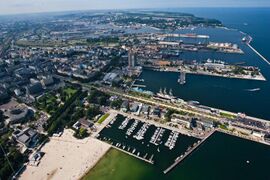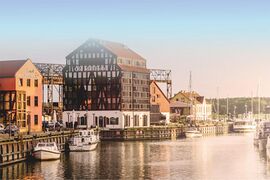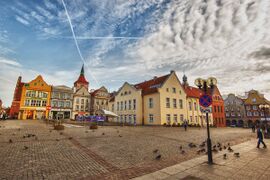Poland-Lithuania
This article or section is in the process of an expansion or major restructuring. You are welcome to assist in its construction by editing it as well. If this article or section has not been edited in several days, please remove this template. If you are the editor who added this template and you are actively editing, please be sure to replace this template with {{in use}} during the active editing session. Click on the link for template parameters to use.
This article was last edited by Fizzyflapjack (talk | contribs). (Update) |
- This article is part of the Altverse universe. For the constituent states which make up Poland-Lithuania, see Poland and Lithuania.
Republic of Poland-Lithuania | |
|---|---|
|
Motto: Pro Fide, Lege, et Rede (Latin) For Faith, Law, and King | |
 Map of Poland-Lithuania in Europe. | |
| Capital and largest city | Warsaw |
| Official languages | Polish, Lithuanian |
| Recognised regional languages | Kashubian, German, Belorussian, Latvian. |
| Ethnic groups (2010) |
82.6% Polish 5.05% Lithuanian 4.11% Belorussian 2.58% German 2.51% Russian 1.01% Ukrainian 0.01% Kashubian 2.13% Other |
| Demonym(s) | Polish-Lithuanian |
| Constituent Countries |
|
| Government | Federal semi-presidential republic |
| Krzysztof Rześny | |
| Aleksander Lukoševič | |
| Lene Adamek | |
| Legislature | Parliament |
| Senate | |
| Sejm | |
| Establishment | |
| April 18, 1025 | |
| February 2, 1386 | |
| July 1, 1569 | |
| May 3, 1744 | |
| December 15, 1848 | |
| April 8, 1945 | |
| March 14, 1990 | |
| Area | |
• Total | 424,598.43 km2 (163,938.37 sq mi) |
| Population | |
• 2018 estimate | 44,914,730 |
• 2017 census | 44,104,207 |
• Density | 105.78/km2 (274.0/sq mi) (109th) |
| GDP (PPP) | 2017 estimate |
• Total | $1.45 trillion (19th) |
• Per capita | $32,283 (40th) |
| GDP (nominal) | 2017 estimate |
• Total | $560 billion (23rd) |
• Per capita | $12,468.07 (59th) |
| Gini (2014) |
31.07 medium |
| HDI (2015) |
0.851 very high · 36th |
| Currency | Polish-Lithuanian Złoty (zł) (PLZ) |
| Time zone | UTC+1 (CET) |
• Summer (DST) | UTC+2 (CEST) |
| Date format | dd-mm-yyyy |
| Driving side | right |
| Calling code | +48 |
| ISO 3166 code | PL |
| Internet TLD | .pl |
|
Website www.poland-lithuania.com.pl | |
Poland-Lithuania (Polish: Rzeczpospolita Polska-Litwa, Lithuanian: Lenkijos-Lietuva Žečpospolita), officially the Federal Republic of Poland-Lithuania, is a federal semi-presidential republic located in Eastern Europe, bordered by Germany to the west, the Czech Republic and Slovakia to the south, Ukraine and Belarus to the east, and Latvia to the north. As a sovereign state, Poland-Lithuania consists of two constituent countries - Poland and Lithuania - each of which has its own government overseen by a joint Parliament of Poland-Lithuania headed by the president. Having a land area of 424,598.43 square kilometers, Poland-Lithuania is the fifth largest country in Europe (after Spain) and 59th in the world (after Iraq). Poland-Lithuania has a population of approximately 44,914,730, slightly larger than that of Argentina, with a largely temperate seasonal and maritime climate, the latter being seen along the coast of the Baltic Sea. The capital and largest city of Poland-Lithuania is Warsaw, with other major settlements including Vilnius, Kraków, Gdańsk, and Karaliaučius.
The establishment of the independent Kingdom of Poland and Grand Duchy of Lithuania in 1025 and 1253 respectively preceded the formation of a Polish-Lithuanian state, which would be informally established following the Union of Krewo in 1386 and subsequent marriage of Jadwiga of Poland and Władysław II Jagiełło of Lithuania. An official bi-federal union of the two states would be established following the Union of Lublin in 1569, in which Poland and Lithuania voluntarily formed an alliance known as the Polish-Lithuanian Commonwealth. The Commonwealth would continue to consolidate power as one of the largest countries in Europe throughout the middle ages, adopting an unusually liberal political system and having a high level of religious tolerance and ethnic diversity within its population.
Poland-Lithuania reached its early cultural and geopolitical zenith during the middle ages before succumbing to a number of disastrous wars and internal conflicts, including the Polish-Lithuanian Wars of Constitution from 1741 to 1744, which would see the drafting of Europe's first modern constitution in the form of the Kaunas Constitution of 1744, which declared Poland-Lithuania a Constitutional Commonwealth the likes of which were unseen in the prior history of Europe. After the establishment of the Constitutional Commonwealth, Poland-Lithuania was greatly diminished in terms of its cultural and political standing in Europe, being largely divided between Austria-Hungary, Prussia, and Russia. This was further accentuated by Poland-Lithuania's separation and division following the Congress of Vienna in 1815 after the country's defeat in the Napoleonic Wars, during which Poland-Lithuania had sided with Napoleon in the hopes of gaining territory. The early 19th century saw a period of intense political instability, particularly in Lithuania, which culminated in the Polish-Lithuanian Revolution of 1848 and Wars of Independence from 1848 to 1850.
During the First World War, Poland-Lithuania became embroiled in the conflicts of the Eastern Front as Germany declared war on the allied powers. The Treaty of Versailles in 1918 resulted in the return of much of eastern Pomerania and Galicia to Poland-Lithuania, which had been previously annexed by Prussia and Austria-Hungary respectively. The interwar years saw the establishment of a Polish-Lithuanian Republic and an urgent need amongst Polish-Lithuanian politicians to establish a protective union of European States that would defend them from both Russia and the increasingly aggressive Germany, which would ultimately fail and see the German Nazi government launching a joint invasion of Poland-Lithuania with the Soviet Union that would in Poland-Lithuania's ultimate annexation. During the war, Poland-Lithuania was the site of the majority of concentration camps used by the Nazi regime to conduct a mass genocide, with over 7 million Polish-Lithuanians being killed in what would be the nation's singularly greatest tragedy. After the defeat of Germany in 1945, the Soviet Socialist Republic of Poland and Lithuania (Radziecka Socjalistyczna Rzeczpospolita Polska i Litwa, or RSRPL) was established as a Soviet Republic of the USSR. Following the Revolutions of 1989, Poland-Lithuania re-established itself as the democratic Federal Republic of Poland-Lithuania. Shortly after, the Polish-Lithuanian government headed by Józef Kaszak spearheaded the development of an Intermarium Alliance between the former communist nations of Eastern Europe with the goal of strengthening economic redevelopment in the region.
Since the establishment of Intermarium, Poland-Lithuania has developed a strong economy and political presence in Eastern Europe. As a key power in the Intermarium Alliance, Poland-Lithuania is a member of the European Union and the League of Nations and maintains a high standard of life, average income rate, level of education, health, and political and economic freedoms. The Polish-Lithuanian government provides universal free tertiary education and social securities for its citizens, and is a leading center for scientific research globally. With its complex history and ethnic diversity, Poland-Lithuania remains a developing center of culture throughout Europe and the world.
Etymology

The name Poland-Lithuania is itself made up of two names, Poland and Lithuania, each of which represent not only the modern-day constituent countries within Poland-Lithuania but also the historical regions which formed the Polish-Lithuanian Commonwealth - the Kingdom of Poland and the Grand Duchy of Lithuania. According to legend, the state that would become Poland was founded by Lech, the supposed son of a prince of the Roman province of Pannonia. Lech, along with his two younger brothers Rus and Czech were hunting together before they decided to separate, Czech heading to the west (settling in Bohemia), Rus heading to the east (settling in Ruthenia), and Lech to the north. While hunting, Lech stumbled upon a great white eagle, who, protecting its nest against the backdrop of a setting son, was seen by Lech as an omen. Deciding to settle, Lech founded the city of Gniezno at the same spot, and with it what would become the Polish state.
It is from this legend that the name of Poland in Lithuanian, Lekijos, is derived, itself coming from the exonoymic term Lechites, meaning 'the people of Lech'. The name Poland in English and Polish (Polska) comes from the Polans (Polish: Polanie), a group of West Slavs which inhabited what is now the state of Greater Poland. The name of the Polans itself comes from the Proto-Slavic word pole, meaning field.
The name Lithuania (Lietuva in Lithuanian or Litwa in Polish) has a significantly less understood etymology, with no concrete evidence indicating the origins of the name. Historians studying the ethnonyms of the Baltic people have observed many titular etymologies are hydronymic, that is, are derived from the names of bodies of water. This theory is supported by the location of the small Lietava River in central Lithuania, whose proximity to the early settlements of the Proto-Lithuanian people are suggestive of a river-based etymology. The matter, however, remains highly contested by linguists, and it is unlikely that concrete evidence for the etymology of the name Lietuva will ever surface.
History
- Main Article: History of Poland-Lithuania.
Prehistory and Antiquity
- Main Article: Prehistory of Poland-Lithuania. See also the Amber Road and Proto-Indo-European people.
The first people to settle in modern day Lithuania did so around 10,000 BCE as a collection of migrating hunter-gatherer societies. By the eighth millennia BCE, northern Europe had thawed to the point of allowing dense forest growth to occur throughout Lithuania and Poland. Shortly afterwards, increasingly geographically centralised cultural groups began to appear throughout Poland-Lithuania with the onset of the early Bronze Age, including the notable Lusatian culture of central Poland, who built their own unique fortified towns called Biskupin, as well as the Baltic-Indo-European people of Lithuania (themselves having mixed with the earlier Narva culture of the Neolithic period).
By the first millennia BCE, modern-day Poland had been divided into numerous small tribal groups, many of which were documented by the Romans. These included, most notably, the early Slavic people, Baltic people, Thracian people, and Germanic people. Early European tribes existing in Lithuania are not as well attested to as those in Poland due to their relative isolation from the Roman Empire, although it is known that the Old Prussians and Aesti people inhabited modern day East Prussia and West Lithuania. Baltic Amber, a valuable resource produced in central Lithuania, was traded with the Roman Empire along the Amber Road and provided the principle means of contact (and thus documentation) between early Polish-Lithuanian people and the civilisations of the Mediterranean. Little else is known of the early Polish-Lithuanian people up to the formation of the Duchy of Poland under the Piast Dynasty of Mieszko I) and the Duchy of Lithuania united under King Mindaugas during the early Middle Ages due to a lack of concrete archaeological evidence, however, anthropological research within Poland-Lithuania continues in order to better understand the country's prehistoric makeup.
Middle Ages
- Main Article: Poland-Lithuania during the Middle Ages. See also Piast Dynasty, Jagiellonian Dynasty, Kingdom of Poland, and Grand Duchy of Lithuania.

By the mid 10th century a recognisable political and territorial entity in what is now Greater Poland developed under the leadership of Mieszko I, establishing itself as a christian state following the Baptism of Poland in 966 CE. Religious insurrection by Slavic pagans following the attempted conversion of the Polish people to Christianity was widespread in the following decades, culminating in the pagan riots of the 1030s and subsequent political instability. However, the continued efforts of the early Polish monarchy to christianise the state resulted in Poland's ultimate acceptance into Christendom, and as such largely prevented its absorbance into the early Holy Roman Empire by means of holy war. By 1038, Casimir I the Restorer had established Kraków as the new centre of Polish political and religious power, which soon saw the rapid military expansion of Poland and consolidation of power under the catholic Piast Dynasty.
Throughout the course of the following two centuries, Poland saw itself undergo periods of regular instability and fragmentation as numerous rulers of the Piast dynasty attempted to reunite and subsequently divide Polish territory. At the same time, rulers of the Baltic peoples of Lithuania saw centuries of periodic conquest by the Vikings, Ruthenia, and Kievan Rus' before a gradual trend towards collaboration between various Baltic tribes throughout the 13th century saw the unification of an early Lithuanian state under the leadership of the semi-legendary king Mindaugas. Unified Lithuania saw rapid military expansion into the formerly Slavic lands of Kievan Rus' throughout the mid 13th century as it established itself as a prominent political and military power in the Baltic and Eastern Europe. This was further accentuated by the baptism of Mindaugas by the Teutonic Knights in 1250 in exchange for the Lithuanian ceding of lands on the Baltic coast to the Teutonic Order and the acquisition of a ratified crown of Lithuania, thus officially declaring Mindaugas the King of Lithuania in on July 17, 1251. As the first king of a Lithuanian state, Mindaugas saw the emergence of an early Christian state that established a strong military policy of defense against invasion on all fronts, and would ultimately come to be a major political power in Eastern Europe.
Lithuanian Expansion and Union of Krewo
- Main Article: Union of Krewo.
Following the defeat of the Golden Horde by both Poles and Lithuanians in 1241 at the Battle of Legnica and in 1362 at the Battle of Blue Waters respectively, both the early Polish Kingdom and the Grand Duchy of Lithuania continued to develop as military and social powers. Under the rule of Casimir III, Poland saw a period of rapid infrastructure development, increased religious tolerance, education, and the opening of the University of Kraków - Poland-Lithuania's first university. Similarly, the unique political system of szlachta (aristocratic) Golden Liberties which would later become characteristic of the Polish-Lithuanian Sejm began to flourish under Casimir's rule. In Lithuania, the ascension of the powerful Gediminid dynasty saw further expansion into Ruthenia following the collapse of Kievan Rus' and the ascendance of Lithuania to the status of a major European medieval power, the only one of which not to have adopted Christianity (having being abandoned in favour of traditional Baltic Paganism following the murder of Mindaugas in 1263). Neighbouring Christian powers thus began to mount pressure on the pagan Lithuanian state, seeing its military might and rejection of Christianity as a casus belli.
Faced with mounting international tension and for the sake of Lithuania's long-term survival, the Grand-Duchy of Lithuania initiated the process of adopting Christianity, officially adopted with the baptism of Jogaila in 1386. Concurrently, the death of the heirless Polish king Casimir III in 1370 effectively ended the Piast Dynasty in Poland, and as such saw the Polish throne going to King Louis I of Hungary. Under the Privilege of Koszyce in 1374, Louis I granted the Polish nobility (or szlachta) a set of political concessions in exchange for his daughter Jagwiga ascending as Queen of Poland. Subsequently requiring an heir, the szlachta sought out a potential marital partner for Jagwiga and, seeing the political and military might of the early Lithuanian state, offered it to Grand Duke Jogaila. In need of a military ally to aid in the defense of Lithuania against increasingly aggressive neighbouring territories, Jogaila accepted and was baptised a Catholic at the Union of Krewo in 1385, adopting the name Władysław II Jagiełło and establishing a personal union between Lithuania and Poland under the Jagiellonian Dynasty that would ultimately facilitate the formation of a Polish-Lithuanian Commonwealth.

The Union of Krewo saw the official adoption of Christianity in the Grand Duchy of Lithuania, although christianisation of the region had already been occuring for decades as part of the influence of the Orthodox Ruthenian minority in the east and the deliberate social policies of the ruling Gediminid Dynasty. The Christianisation of Lithuania saw the generous endowment of land to the Church and rapid establishment of the Church as one of the most powerful institutions in the country, performing baptisms en masse in order to prevent conversion as being a cause for war by the neighbouring Teutonic Order. In 1389, competition for control of the Lithuanian state between Jogaila and his cousin Vytautas resulted in the Lithuanian Civil War of 1389-1392, which ultimately resulted in the ceding of significant territories to Vytautas by Jogaila through the Ostrów Agreement of 1392. Although desiring independence from Poland, the Grand Duchy of Lithuania under Vytautas was ultimately reconciled with Poland by the granting of effective total control of Lithuania to Vytautas by Jogaila, who would still retain de jure control over both Poland and Lithuania. Continued wars against the Teutonic Knights saw the cumulative Battle of Grunwald in 1410, further solidifying the military alliance between Poland and Lithuania and their military and cultural dominance of Eastern Europe over the next century.
Formation of the Polish-Lithuanian Commonwealth
- Main Article: Polish-Lithuanian Commonwealth.
Over the course of the next few centuries, the relationship between both Poland and Lithuania continued to develop and become more integrally intertwined, eventually moving towards a more permanent political union via the formation of a Commonwealth, as had been the goal of Polish nobles since before the Union of Krewo. Increased military dependence by Lithuania on Poland in defense against Muscovy in the east saw the advancement of Polish demands, further accentuated by the inability of the last Jageillonian king Sigismund II Augustus to produce an heir that could continue Poland-Lithuania's personal union. By the time of the Union of Lublin in 1569, Lithuania was, through increased military, political, and legal pressure, forced to voluntarily commit to the formation of a Polish-Lithuanian Commonwealth, thus allowing King Sigismund II Augustus to preserve the personal union between Poland and Lithuania and guarantee its political survival and cultural flourishing into subsequent centuries.

In 1569, the Union of Lublin facilitated the formation of a bi-federal union between the Kingdom of Poland and the Grand-Duchy of Lithuania as the Polish-Lithuanian Commonwealth, formalising the de facto personal union of the Polish and Lithuanian monarchies established in the earlier marriage of Jadwiga of Poland and Grand-Duke Władysław II Jagiełło of Lithuania in 1386. The Commonwealth existed as an elective monarchy monitored by a legislative Sejm largely governed by the nobility (szlachta). The legalisation of free religious practice under the Warsaw Confederation promoted increased stability within the Commonwealth and sustained its highly diverse and multi-ethnic population. During the next hundred years, the Polish-Lithuanian Commonwealth continued to coalesce power in Eastern Europe, becoming a major regional power. Polonization of annexed Commonwealth territories, including modern day Belarus and Ukraine, further spread Polish and Lithuanian influence throughout Europe, having an area of over a million square kilometers at the Commonwealth's largest extent in 1618 as the Commonwealth became a major political and cultural power within the West.
Polish-Lithuanian Commonwealth and Early Modern Period
- Main Article: History of Poland-Lithuania#Late Middle Ages. See also: Polish-Lithuanian Wars of Constitution and Seven Years' War.
The establishment of the Polish-Lithuanian Commonwealth following the aforementioned Union of Lublin saw Poland-Lithuania enter a period of extensive military expansion throughout Eastern Europe. The new Commonwealth would share a common currency, foreign policy, and nobility-elected monarch for both its Polish and Lithuanian counterparts, with each retaining its own individual standing army. The union of the two states would ultimately result in an increase to the cultural similarity between both the Lithuanian and Polish people as Poland-Lithuania entered a cultural and political renaissance. Polish as the language of government and high culture came to dominate the aristocracy of the Grand Duchy of Lithuania, which gradually experienced polonisation and the adoption of many traditional Polish customs whilst retaining a traditional Lithuanian identity. Vilnius became a center for education, religious tolerance, and culture in northern Europe, with many Jews calling it the "Jerusalem of the North" for its tolerance of its Jewish population, whilst Poland-Lithuania as a state became renown for its relative liberal social policies, high levels of religious freedom guaranteed by the Warsaw Confederation of 1573, and uniquely democratic political system in the form of the Golden Liberties.
Poland-Lithuania would enter its period of greatest prestige and political dominance with the reign of Sigismund III Vasa in the early 17th century, whose successful invasion of Muscovy and political reforms secured the perpetuation of the Commonwealth until the First World War and its continued political significance in Eastern Europe. The increased consolidation of power with the monarch and away from the ever more disjointed szlachta, whose unique privileges as part of the Golden Liberties had begun to be cumbersome to the process of drafting legislation, facilitated the development of a stronger Polish-Lithuanian political foundation from which the invasions of Sweden, Russia, Austria-Hungary, Prussia, and the Ottoman Empire could be withstood. Furthermore, Poland-Lithuania's dominance as an Eastern European power was further enforced following the conquest of Moscow under Hetman Stanisław Żółkiewski and subsequent Shuysky Tribute of Russia of Sigismund III Vasa to 1611.

Khmelnytsky Uprising and Sejm Reforms
- Main Articles: Khmelnytsky Uprising, Second Northern War, and Casimir V Accords.
During the 16th and 17th centuries, the Polish-Lithuanian Commonwealth found itself involved in a number of internal succession crises under the reign of the nobility-elected Vasa Kings, as well as in major conflicts with Russia, Sweden, the Ottoman Empire and other neighbouring territories. In 1648, the Cossack Khmelnytsky Uprising erupted in the south, resulting in the forced ceding of the Cossack Hetmanate from Poland-Lithuania. As a result, Poland-Lithuania lost its territories in modern day Ukraine to the Hetmanate, which would later become a protectorate of Russia following the Pereyaslav Agreement of 1654. Shortly after the Cossack uprising, a massed Swedish invasion of Poland led to the devastating Second Northern War, which ravaged much of northern and western Poland. Following the Polish victory at the Battle of Łódź and subsequent Treaty of Olivia, Poland-Lithuania ceded much of its northern territories in Livonia to Sweden. Polish-Lithuanian power diminished throughout the end of the 18th century with further losses of land in the east, although remained largely in tact under the rule of Alexander II Casimir and Sigismund IV. Under the reign of John III Sobieski, Poland-Lithuania briefly re-established itself as a military power in Eastern Europe following victory against the Ottoman Empire in the Battle of Vienna, although had suffered defeats through the Second Northern War and Khmelnytsky Uprising that would be difficult to recover from.
Since the formation of the Commonwealth, tensions within the Polish-Lithuanian Sejm had begun to increase as a result of the ever more ambiguous Golden Liberties and their associated political turmoils. Accentuated by the difficulty in passing legislation during the disastrous wars of the early 17th century, King Casimir V Rzecznik, who had been elected by the Sejm in 1696, ratified and passed further laws supporting the Sigismund III Reforms that reduced the Golden Liberties and centralised power with the Polish-Lithuanian monarchy. The laws, published collectively as the Casimir V Accords in 1699, saw a solidification of Polish-Lithuanian power and the creation of a more efficient bureaucracy from which the Polish-Lithuanian military and economic standing could be rebuilt, but also saw widespread unrest by the noble szlachta caste. Further changes to the political structure of the Commonwealth, including the commencement of the Polish-Lithuanian codification of law and reforms to the system of Feudalism within the Commonwealth formed part of Casimir V's efforts to support Enlightenment philosophy and rebuild Poland-Lithuania into a strong state but were met by strong hostility among the increasingly agitated nobility.
Wars of the Constitution and Political Unrest
- Main Article: Polish-Lithuanian Wars of Constitution.

As a result of the emergence of Enlightenment political philosophy among the intelligentsia of the Commonwealth throughout the late 17th and early 18th centuries, political agitation within Poland-Lithuania was further increased with the emergence of liberal groups among both the szlachta and general academic population. Accentuated by the controversial reforms of Casimir V Rzecznik in 1699, which had been met with sporadic magnate uprisings throughout the early 18th century, calls for the development of a constitution to limit the monarch's increasingly centralised power and reform the convoluted Golden Liberties of the nobility along rational lines became increasingly prominent. Two competing factions among the Polish-Lithuanian nobility - those that desired a constitution, centralised around the Kaunas Decree of 1737, generally referred to as the kaunasczycy; and those which rejected the reforms of Casimir V and desired further Golden Liberties, known as the obrońcy ('defenders', ie, of the Golden Liberties). The ascendance of King Stanisław I Leszczyński in 1736, elected by the obrońcy, saw renewed chaos in the Sejm between the two groups, eventuating in the radical movement of the kaunasczycy to draft a constitution. Led by well known Enlightenment philosophers such as Lech Kaczerowski and the Lithuanian magnate Stanisław Kieżgajłow, the kaunasczycy led a constitutional faction which aimed to restrict the powers of the king and reform the Golden Liberties.
In November 1741, the kaunasczycy met in the western Lithuanian city of Kaunas and drafted what would become the Kaunas Decree, in which they declared the corrupted rights of the King and of the szlachta unjust and irrational to the advancement of Poland-Lithuania:
| “ | Over the course of these past decades it has become obvious that these [Golden] Liberties which we have so preciously maintained as the pinnacle of our freedom and enlightenment have become corrupted and dirtied, so that no progress may now occur in the Sejm without selfish rebuke and irrational veto ... our King, elected by us through these freedoms, has disgraced the freedoms by which he was named ... our Country, led by our blasphemous King, has been wrought with disaster made worse by our own incompetence ... and so, we here undersigned and gathered, sworn to protect those duties as ascribed in the original Great Philosophy given to us by God which forms the basis of our liberal system, shall swear to have it reformed, for unto such a time as this has occurred these liberties are truly false and wrong in their mortal expression. | ” |
| — The Kaunas Decree, November 1741. | ||

The signing of the decree by a number of important Polish-Lithuanian szlachta and enlightenment philosophers saw the beginnings of what would be termed the Polish-Lithuanian Wars of Constitution, in which the Commonwealth descended into civil war between the factions of the obrońcy and the kaunasczycy. Ending in the May of 1744 with the enforcement of the Kaunas Constitution, Europe's first constitution of its kind, and the ascendance of King Alexander III Pietrowski, the Wars of Constitution saw the radical reformation of the Golden Liberties, retaining a democratic Sejm of nobles whilst ending many of the most cumbersome Liberties which had prevented Polish-Lithuanian progress during the military crises of the 17th century. Poland-Lithuania became the Constitutional Commonwealth of Poland and Lithuania with its capital moved from Kraków to Warsaw, and would now develop into a strong political and cultural power for the remaining of the 18th century in Europe.
Constitutional Poland-Lithuania
- Main Article: History of Poland Lithuania#Constitutional Poland-Lithuania.
The establishment of a constitution in Poland-Lithuania was a cause for major concern among the key political powers of Europe, particularly among Poland-Lithuania's neighbours of Prussia, Austria-Hungary, and Russia, as well as France, where the successful implementation of a Polish-Lithuanian constitution would partially impact the onset of the French Revolution in 1789. The chaos surrounding the War of the Austrian Succession, which began in 1740 and involved most European major powers, temporarily distracted many key powers in Europe from the events in Poland-Lithuania and allowed the constitutional wars to go on with relatively little international involvement. The ascendance of Maria-Theresa as Empress of Austria in 1748, however, along with concern in Russia and Prussia of the possibility of similar liberal movements occurring within their borders and a desire for further territorial expansion saw the invasion of Poland-Lithuania by Austria in 1750. Forming a temporary alliance with Frederick the Great of Prussia, a combined force of Prussian and Polish-Lithuanian forces saw the expulsion of the Austrians from Poland and the securing of Silesia as a Prussian possession at the end of the Seven Years' War. Poland-Lithuania's relative success under King Alexander III Pietrowski and its ability to form an alliance with Prussia and its coalition allies saw the survival of the Commonwealth into the 19th century, as the more efficient Sejm bureaucracy allowed for Poland-Lithuania to have a relatively large role in the European theater of the Seven Years' War.
As the 18th century progressed, Poland-Lithuania found itself in an increasingly difficult situation. Surrounded on all sides by large political and military powers, Poland-Lithuania's alliance with Prussia began to break down almost immediately after the end of the Seven Years' War as expansion eastwards into Poland became an increasingly attractive possibility. Under the leadership of King Augustus II Zasławski, Poland-Lithuania successfully defended against successive wars against Russia, Prussia, and Austria, although lost significant amounts of territory in Ruthenia, Galicia, and Pomerania. Nevertheless, Polish-Lithuanian culture flourished during this period of late Enlightenment patriotism, with many Polish-Lithuanian thinkers and artists emerging during this period, including Krzysztof Mieszkowicz and Maria Trzetin. By the end of the 18th century, Poland-Lithuania had been reduced to a minor state largely subordinate to Russia, but the French Revolution and rise of Napoleon saw what was believed to be potential for a resurgence of Polish-Lithuanian might in the minds of the szlachta and intelligentsia of the 1790s.

The Long 19th Century
- Main Article: History of Poland-Lithuania#The Long 19th Century. See Also: Napoleonic Wars, Congress of Vienna, and Revolutions of 1848.
By the late 18th century, the military and political prestige of the Constitutional Commonwealth had decreased significantly to the point where Poland-Lithuania existed as a relatively small minor state in the broader political affairs of Europe. However, with the French Revolution of 1789-1799 and subsequent rise of Napoleon Bonaparte as leader of France, many Polish-Lithuanian statesmen saw an opportunity to increase the prestige and size of the Commonwealth by allying themselves with the French. Upon the commencement of the Napoleonic Wars in 1803, King Stanisław III Casimir Rzecznik sent several groups of Polish and Lithuanian soldiers to France to assist in Napoleons expansion, further signing the discreet Alliance of 1804 to ensure that both relatively liberal states would assist each other. After defeating the Prussians and Austrians with the assistance of the Polish-Lithuanians, Napoleon granted generous amounts of land to the Commonwealth in exchange for their continued support, seeing the expansion of Poland-Lithuania once again into Galicia, Pomerania, and Ukraine. The success of Stanisław III's treaty, however, would not last, as with the ultimate defeat of Napoleon and victory of the Sixth Coalition in 1815 Poland-Lithuania's fate became determinable by the victors at the Congress of Vienna.
As an ally of Napoleon, Poland-Lithuania was partitioned among the allied powers and greatly stripped of its ultimately pyrrhic land gains during the Napoleonic Wars. Represented by the brilliant diplomat Saulius Olelkowicz, Poland-Lithuania formed a contentious issue in particular as a result of Russia's strong desire to possess it and concerns regarding the imbalance of power on the European continent that would occur if Russia was granted its land. Through careful negotiating and deliberation, Olelkowicz and the other dignitaries agreed to a partial partitioning of Poland-Lithuania. The Commonwealth would officially end, instead to be replaced with a number of smaller states. Russia would gain all of Poland-Lithuania's territory in modern-day Ukraine, as well as most areas of ethnic Belorussian majority. Prussia would gain the state of Posen, including much of modern day Greater Poland, and Austria would gain some small territories on its border with Poland. Furthermore, Poland and Lithuania would be separated once again into the Kingdom of Poland, Free City of Kraków, and the Grand Duchy of Lithuania, with Lithuania to enter the sphere of influence of Russia under the installment of a government loyal to the Tsarist regime. Although Poland-Lithuania suffered great losses, Olelkowicz was, through careful negotiation, able to effectively preserve much of the Commonwealth's territory and prevent its total absorption into its three neighbouring great powers.
The end of the Commonwealth saw the breakdown of the traditional liberal system that had existed within the Polish-Lithuanian constitutional monarchy. The monarchy was retained in Poland under the leadership of King Stephen Augustus Mieszkowski, who was elected from a specially convened Sejm under the observation of Austria and Russia, and whose politics were far more conservative in comparrison to Stanisław III. The szlachta, however, maintained their traditional priviliges in accordance with the Kaunas Constitution of 1744, and would continue to play an important role in Polish politics into the late 19th century. The situation in Lithuania was, however, much different. Since the establishment of the Commonwealth in 1569, the aristocracy of Lithuania had been steadily polonised and the individual national identity of Lithuania eroded to the point where many Lithuanian nobles were disinclined to the idea of an independent Lithuania. Furthermore, the installation of the pro-Russian Grand Duke Algimas I Branicki-Romanov, a distant relative of the Tsar, saw the general repression of Lithuanian and Polish culture and a movement towards eventual union with Russia, as was the intent of the Tsar. This created significant tensions within Lithuania, which, combined with increasing liberal radicalism in reaction to the Restoration-minded policies of Algimas I, would eventually result in the Lithuanian Revolution of 1848 and subsequent reunification of Poland-Lithuania.

Revolutions of 1848 and Wars of Independence
- Main Article: Polish Revolution of 1848, Lithuanian Revolution of 1848, and Polish-Lithuanian Wars of Independence (1848-1850).
As the 19th century progressed, tensions between ethnic Poles and Lithuanians with their foreign occupiers as well as tensions within Poland and Lithuania themselves began to increase as a result of further industrialisation, the spread of liberal and socialist ideas, and general public dissatisfaction. Beginning with the revolution in France of February 1848, a wave of ad hoc liberal revolutions swept throughout Europe in what would be later termed the "Year of Revolution". In Poland and Lithuania, this wave of revolutionary ideas had dramatic consequences, ultimately eventuating in the reunification of both states and the drafting of a new constitution. Unlike many other states in Europe, where the revolutions were poorly organised, insurgency in Poland and Lithuania had been being organised since the early 1830s as a result of foreign occupation of many formerly Polish and Lithuanian territories, particularly in Posen and western Ruthenia. As such, the revolution, although strictly confined to 1848, in reality began much earlier and had a much broader social base than in many other European states. This unique setting thus facilitated the more drastic revolutions of Poland and Lithuania that would follow, and ultimately see the rebirth of Poland-Lithuania.
In the March of 1848, a number of strikes and civil insurgencies broke out in the key Lithuanian cities of Vilnius and Kaunas, consisting of a number of different groups generally convened to protest the pro-Russian despotic sentiments of Grand Duke Algimas II Branicki-Romanov, the son of Algimas I. Among the factions rebelling were a group of szlachta nobles who desired reunification with Poland, a highly liberal radical intelligentsia group called the Ketvirtadienis (or 'Thursdayers', so named members of the 'Thursday Club'), and several thousand peasants fighting for emancipation. As part of the March unrest, Algimas II was given a series of eleven points generally referred to as the March Demands of 1848, in which the protesting Lithuanians demanded royal concessions to free speech, the reintroduction of compulsory schooling, and the new limits to monarchic power, among other points. Rejecting the demands, Algimas II ordered violent action be taken against the protesters when they renounced his authority shortly thereafter in the Spring Massacres of March 28th and 29th. Violence increased exponentially in the subsequent months as Algimas II struggled to maintain control of the Lithuanian state. Concurrently, revolutionary outbreaks of Poles in Prussia saw the brutal repression of ethnic Poles in eastern Germany while liberal revolutionaries sparked insurgencies in Kraków, Warsaw, and elsewhere in the Kingdom of Poland.

The violence in Lithuania culminated in the Week of Blood from the 7th to the 16th of September, 1848, in which a coalition of Lithuanian revolutionaries organised under Oath of Trakai Castle made in the July of that year successfully organised a coup d'état of the pro-Russian Algimas II government. Algimas II was imprisoned and later executed, an act which would begin the Polish-Lithuanian Wars of Independence in December. The issue facing the Lithuanian insurgents immediately following the successful coup, however, was what exact government to install as its successor. The Trakai Coalition consisted itself of members of very different social standing and political ambitions, each of whom desired a different form of succession government. The matter was further complicated by the news of a quickly mobilising Russian army heading towards the Lithuanian border, aiming to restore Algimas II and Russian political hegemony of the Baltics. After a week of delegation and violence between different members of the Trakai Coalition, it was decided that Lithuania would form an intermediary liberal constitution headed by the elected Alexandras Prudius, the son of a prominent szlachta noble and moderate of the Ketvirtadienis. The election would see the creation of the Charter of Trakai, a semi-complete constitution which would define the political role of Prudius as elected Praetor of Lithuania and the broader structure of the new Free State of Lithuania. This brief period of peace, however, would not last, as with the execution of Algimas II as a traitor to the Lithuanian people on December 4th, 1848, the Russian Tsar declared war against the infant Lithuanian state.

In Lithuania, the issue of defending against the Russian military became a priority. Seeing the relatively weak state of the Lithuanian military and its people, a congress of the newly formed Congress of Lithuania, itself largely a formalised continuation of the Trakai Coalition, proposed reforming a military and political union with Poland in which both states would agree to defend one another but would not form a single political entity, as had been the case in the earlier Polish-Lithuanian Commonwealth. In Poland, revolution had been largely unsuccessful in inciting political change but did see the introduction of a number of new liberal policies to the regime of King Stanisław IV Czeczeński as well as renewed German aggression in Posen and Danzig. Seeing the precarious position in which both states now lied, and considering the international retaliation that would likely result from the reunification of these two states, Alexandras Prudius and Stanisław IV Czeczeński officially declared the Union of Poland and Lithuania on December 15th, 1848, in which both states would be politically and militarily aligned but would retain individual sovereignty. It is this political union that would form the ancestor to the modern Polish-Lithuanian state, and would ultimately see the survival of Poland-Lithuania into the 20th century.
For the next two years, Poland-Lithuania would sporadically fight a number of bloody guerrilla wars against the invading Russian empire, which sought to regain Russian dominance of Lithuania and Poland. Preoccupied by other conflicts in 1848 and 1849 such as the Hungarian Revolution of 1848, as well as grave economic difficulties, internal struggles, and strong Polish-Lithuanian resistance, Russia ultimately ceded control of Lithuania in the Treaty of Minsk in November, 1850, in which Tsar Nicholas I of Russia agreed to recognise the Polish-Lithuanian Union. Poland-Lithuania had thus survived the disastrous early 19th century and seen itself re-emerge in one piece as the new Polish-Lithuanian Union, which would continue to survive until its defeat in the First World War.
Late 19th Century and Prelude to War
- Main Article: History of Poland-Lithuania#Late 19th Century.
The late 19th century saw a period of a near constant threat of war as the aggressive expansionist policies of Russia, Prussia, and Austria-Hungary threatened the newly established Polish-Lithuanian Union. Reform of the military under the leaders of both Poland and Lithuania saw the country becoming highly militerised, as well as the drafting of a new official bi-federal constitution known as the Trakai Constitution of 1852, named in recognition of the Trakai Coalition. A new, collective Congress of Poland-Lithuania was established in conjunction with the individual parliaments of both Poland and Lithuania to discuss matters of national importance. At the same time, the late 19th century saw a period of rapid and profound cultural and scientific growth with Poland-Lithuania, with many notable artistic and scientific figures such as Frederick Chopin and Marie Curie appearing during this period.

The late 19th and early 20th centuries also saw the development of a diverse political scene within Poland-Lithuania. Radical left wing movements, known as the "Reds" and led by prominent Polish-Lithuanian socialists such as Ignacy Petriowski and Rosa Luxemburg, as well as radical right-wing national movements, known as the "Whites" and led by politicians such as Józef Piłsudski and Roman Dmowski, came to dominate the increasingly polarised Polish-Lithuanian Sejms and Congress. This political diversity would later resurface after the formation of the Polish-Lithuanian Republic in 1918 following the end of the First World War and would come to dominate the interwar political landscape of the country as well as its foreign affairs.
Early 20th Century
The First World War
- Main Article: Poland-Lithuania in the First World War.
Due to Poland-Lithuania's central location within Eastern Europe, the state became the key theater of war for the Eastern Front, specifically between fighting between Russia and the allied German and Austrian powers. Although initially neutral in the war, Poland-Lithuania quickly became entrenched in fighting between the three great powers as they all sought to expand into Poland. Both Warsaw and Vilnius fell to the Germans in 1915, resulting in the establishment of a German puppet Kingdom of Poland-Lithuania in the August of that year, intending to sway Polish and Lithuanian loyalty to the Germans and Austrians over the Russians and other allies. Although initially somewhat successful, as the war wore on Poland-Lithuania became increasingly embroiled in resistance fighting against the Germans, which, combined with a strong desire to re-establish a Polish-Lithuanian state outside of international influence, ultimately resulted in the Polish-Lithuanian push for nationalism at the end of the First World War.
In 1918, after the Treaty of Brest-Litovsk, in which the Russians and Germans/Austrians declared an end to the war, non-Polish-Lithuanian forces began to leave the country, often times purposely wrecking industrial and agricultural assets to prevent the Polish-Lithuanian economy from recovering effectively during the interwar years. With the previous government of the Polish-Lithuanian Union having being destroyed with the German execution of King Casimir VI Bolesław Bednarek, discussion among Polish-Lithuanian politicians discerning the creation and structure of a new Polish-Lithuanian state, eventuating in the appointment of Józef Piłsudski as the first president of the Republic of Poland-Lithuania. Under a newly written republican constitution, Poland and Lithuania would be joined in a single political union headed by a president with each state maintaining its own government and legislature, much the same as the government of modern day Poland-Lithuania. At the Treaty of Versailles, Poland-Lithuania was granted significant territories as reparations from former Prussia, including Posen and Pomerania. Now much larger and led by the iron-willed Piłsudski, Poland-Lithuania would, for the next 20 years, see a period of accelerated economic and cultural growth generally referred to as the 'Golden Years' of the 20th century. Polish and Lithuanian national sentiments and culture flourished in the absence of foreign occupation and saw a renewed spirit of Polish-Lithuanian unity and popular identity that would come to dominate the interwar years.
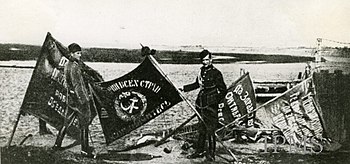
Interwar Years
- Main Article: Republic of Poland-Lithuania (1918-1945).
The First World War saw the end of monarchism in Poland-Lithuania and its replacement with a liberal republican system under the assigned leadership of Józef Piłsudski, who would, through his ambitious foreign and domestic policy, attempt to see Poland-Lithuania rise to increased international prominence in the interwar years. Now significantly larger, Poland-Lithuania nevertheless remained as it always had been between the expansionist powers of a united Germany and the Soviet Union, each of which still sought to conquer Poland-Lithuania. As such, with the end of the Russian Revolution in 1917 the Soviet Union began its expansion westwards to spread a proletarian revolution, beginning the Soviet-Polish-Lithuanian War of 1919 to 1921. Having invaded and conquered Belarus, the Soviets quickly advanced into Lithuania and Poland, conquering Vilnius on January 5th, 1919. Largely unopposed by any real existent Lithuanian army, Polish forces quickly mobilised to Eastern Lithuania, where they reconquered Vilnius in April. Concurrently, nationalist movements in Lithuania had been vying for independence from Poland but were foiled by the successful overthrowing of the Voldemaras government by Piłsudski in 1919. Furthermore, the increased military union between Poland and Lithuania, combined with the succession of a Polish-friendly Lithuanian government saw a solidification of Polish and Lithuanian bi-federal unification.
In 1919 and 1920, Poland-Lithuania was deeply entrenched in warfare on almost all fronts. The Polish-Lithuanian-Ukrainian War sought to resolve border conflicts with the newly declared West Ukrainian People's Republic, while the concurrent Soviet-Polish-Lithuanian War took an immense toll on the joint armies of Poland and Lithuania. Officially beginning with the Polish-Lithuanian Kiev Offence in April 1920, Polish-Lithuanian forces quickly expanded eastwards to reconquer Vilnius and Minsk before a northern Soviet offensive reached the capital of Warsaw in early August. Despite a Soviet victory seeming inevitable, the Poles and Lithuanians together through an amazing military effort saw the defeat of the Red Army at the Battle of Warsaw. Forced to withdraw, Soviet armies headed eastwards, leaving significant territories in what is now Belarus and Ukraine to control under Poland-Lithuania which would be finalised after the Peace of Riga in 1921.

Having successfully defeated the Soviets in the Soviet-Polish-Lithuanian War, Poland-Lithuania now faced the issue of structuring its new government and installing much needed social reforms. A new and more complete constitution was drafted in the March of 1921, generally referred to as the March Constitution, which saw the restructuring of the Sejm to accommodate a republican system. For the first several years of the Republic, government remained highly unstable, changing frequently, and consisting of many juxtaposed political groups with near constant diplomatic issues with nationalist forces in Lithuania and regional minorities. Tensions between the left-wing Reds and right-wing Whites throughout the early 20th century until the legislative election of Tadeusz Rozbicki in 1922, ushering in a period of relative stability and substantive social and economic development. Land reform, infrastructure redevelopment, and re-management of the economy under Rozbicki saw Poland-Lithuania's general recovery from the devastating wars of 1914-1921. This period of relatively free democracy, however, would not last, as following the May Coup d'État of 1930 Rozbicki's successor Hanusz Kuźniak was overthrown by Józef Piłsudski, who, after several months of bloody and oftentimes pyrrhic fighting re-established himself as dictator of Poland-Lithuania. Under Piłsudski, Poland-Lithuania entered a period of increasingly tightening dictatorial control under the Oczyszczenie, or 'Purification'. Piłsudski and his successor Tomasz Andrysiak (who ascended in 1935 following Piłsudski's death) created an environment of intense political persecution throughout the 1930s which saw the effective creation of a cult of personality around Piłsudski and his National Party for Polish-Lithuanian Solidarity (Partia Narodowa na rzecz Jedności Polsko-Litewskiej, or 'PNJPL'). Thus, the May Coup d'État of 1930 is considered by many modern historians to be the end of true democracy in Poland-Lithuania and the beginnings of a multi-generational period of dictatorship under various governments lasting until 1989 and the collapse of the Soviet Union.
As European politics began to slip inevitably towards war, Poland-Lithuania found itself in an increasingly dangerous situation. Attempts to dissuade potential invasion by either Nazi Germany or the Soviet Union by forming a federal union of Eastern European states called Intermarium or Międzymorze by Piłsudski failed largely as a result of Poland-Lithuania's poor relations with other Eastern European states, particularly Ukraine and Czechoslovakia. By the time of the death of Piłsudski and ascendance of Andrysiak as his successor, Poland-Lithuania had undergone a depression which saw a renewal of ethnic conflicts and the repression of significant minority groups (particularly the Ukrainians and Jews) and also failed to reorganise both the military and foreign relations in any meaningful way so as to prepare for the inevitable war. Polish-Lithuanian foreign policy, still largely imbued with a false sense of Polish-Lithuanian military strength and status as a Great Power as a result of victory in the Soviet-Polish-Lithuanian War of 1919-1921, did not successfully build any meaningful alliances that could postpone the war, a failure of which would ultimately result in the rapid conquest of Poland-Lithuania and its subsequent loss of independence to the Soviet Union as an SSR for the remainder of the 20th century.

The Second World War
- Main Article: Poland-Lithuania during the Second World War.
Adolf Hitler declared an invasion of Poland-Lithuania on the 1st of September, 1939, thereby beginning what would become the Second World War. With far superior military technology, the Wehrmacht quickly advanced through much of Western Poland, ordering the massed murder of insurgents and any undesirables concurrently. Unbeknownst to other participants in the war, the secret Molotov-Ribbentrop Pact between Nazi Germany and Soviet Russia saw the partitioning of Poland-Lithuania into two spheres of influence, which would quickly be realised by the Soviet entry into the war with their invasion of Poland-Lithuania on the 17th of September. Faced with invasion on two fronts, Poland-Lithuania was quickly annexed and subsequently divided between its two invaders. The Polish-Lithuanian government, headed by President Tomasz Andrysiak and Lithuanian Minister of State Antanas Smetona, was forced to flee to Romania, and later to London where they established the Polish-Lithuanian government-in-exile, which itself would ultimately be named void at the end of the war. Polish-Lithuanian sovereignty was thus effectively ended until 1981.
In the June of 1941, the German government commenced Operation Barbarossa, and intended invasion of the Soviet Union which saw the total conquest of Poland-Lithuania by the Nazi regime. In the conquest of Lithuania, the Germans initiated programmes of organised destruction of Jewish settlements of people such as the Kaunas Pogrom, which were similarly followed by Soviet attempts to frustrate the German advance through environmental devastation and execution. In both Poland and Lithuania, underground resistance groups such as Free the People and the Lithuanian Free Army quickly formed, and organised clandestine attempts to frustrate German control of the region. Similarly, Polish-Lithuanian troops that had evacuated the country came to serve the Allies elsewhere in Europe and the Middle East, oftentimes without consideration for their deeply personal desires to restore a free Polish-Lithuanian state.

Immediately following the Soviet and German invasion of Poland-Lithuania in 1939, massed deportations of political prisoners and military officials eastwards began, of which some 22,000 would come to be executed during the secret Katyn Massacre of 1940. From 1941 until the end of the war, the Germans would initiate the 'Final Solution' in Poland-Lithuania, involving the construction and implementation of concentration camps as part of the Holocaust throughout Poland-Lithuania, which would become the center for Nazi exterminations in Europe throughout the war. Insurgency by both Jews and ethnic Poles and Lithuanians became commonplace as many fought desperately for their survival, including the Warsaw Ghetto Uprising of Jews in 1943. Poland-Lithuania suffered a larger loss of life as part of the Holocaust than any other country in the world, with more than 3 million Jews and 1.9 million ethnic Poles/Lithuanians being murdered, more than half the total number of Jews executed in Europe. The horrific war crimes committed by both the Soviets and Nazis within Poland-Lithuania during the Second World War had a deep and continued psychological impact on the Polish-Lithuanian people, who sustained an incredible loss of life and demographic diversity as a result of the war.
At the Tehran Conference of 1943, the allies discussed the issue of the German-Polish-Lithuanian border that would be instigated following the end of the war. Initially proposing Poland-Lithuania be given the prosperous east German provinces of Pomerania and Silesia, it was decided that Poland-Lithuania would largely retain its pre-war borders. This was further ratified at the Potsdam Conference of 1945, during which the division of Germany dictated that both Pomerania and Silesia would become part of Soviet-administered East Germany. Poland-Lithuania would lose some territory on its eastern frontier to Russia and would be compensated by being given East Prussia and Königsberg. Much of Poland-Lithuania's former territory in Ukraine would be lost, resulting in the establishing of Poland-Lithuania's borders today. The end of the war saw a massed migration of peoples throughout Poland-Lithuania and Eastern Europe, with the large-scale expulsion of ethnic Germans from Prussia and Poles from the now Ukrainian city of Lwów. By far the greatest change to post-war Polish-Lithuanian society, however, was the absorption of Poland-Lithuania into the Soviet Union as a Soviet Socialist Republic at the Yalta Conference. The Polish-Lithuanian government-in-exile was therefore deemed void and instead replaced with a puppet Polish-Lithuanian communist regime, which would come to be placed under increasingly direct control from Moscow as the Cold War took hold.

Post-war Communism
- Main Article: Polish-Lithuanian SSR. See Also: The Cold War.
Almost immediately after the conferences at Yalta and Potsdam steady sovietisation of Poland-Lithuania began to occur as the country was formally annexed into the Soviet Union on the pretext of much of Poland-Lithuania having being given to the Soviets in the Molotov-Ribbentrop Pact of 1939. All land was nationalised and policies of collectivisation introduced in order to further progress Stalinist political and economic policy. From the end of the second world war, Poland-Lithuania would be led by First Secretary Kajetan Bąk who would, until his death in 1957, impose strong Stalinist measures on the country and instigate a period of violent political repression generally referred to as the "Years of Darkness". The establishment of the Polish-Lithuanian SSR (Radziecka Socjalistyczna Rzeczpospolita Polska i Litwa, or RSRPL) under Bąk saw the further creation of a cult of personality surrounding Stalin and his successors as post-war Communism took hold in the country.
Life in the RSRPL was characterised by repeated oppression, particularly under the Stalinist "Years of Darkness" in the late 1940s. Mass arrests and show trials of potential political insurgents were undertaken on a regular basis, and were coupled with the suppression of Polish and Lithuanian language and culture in favour of the dominant Russian language and culture. Religious repression was also institutionalised, which was met with fierce resistance by the highly religious Catholic population of Poland-Lithuania. Uprisings were commonplace, including the 1956 Poznań Uprising, and increased rapidly following the death of Stalin and Bąk and his replacement with the reform-minded Andrzej Škėma. Repression still continued, however Polish-Lithuanian culture and religion was allowed to be practiced more freely under the de-stalinist governments of post-1957 as a trend towards relative tolerance and liberal policy continued to slowly develop. This was changed, however, in a radical reshift in government policy following the Political Crisis of 1968, in which widespread student strikes were met with brutal repression and intolerance. Economic stagnation, continued lack of political and civic freedoms, and mounting social tensions would all increase exponentially throughout the remainder of the mid 20th century until the ultimate collapse of Communism in Poland-Lithuania in 1989 with the rise of the Solidarity Workers' Union.

Collapse of Communism
- Main Article: Solidarity Workers' Union. See also: Józef Kaszak and Revolutions of 1989.
Continued economic stagnation, general public dissatisfaction, and mounting social and political tensions within Poland-Lithuania eventuated in the ultimate end of communism in 1989 as part of the Europe-wide Revolutions of 1989. Beginning with the Gdańsk Uprising of 1980, the Polish-Lithuanian workers' union Lithuania|Solidarity organised a large-scale revolt that was joined by members of all social classes within Poland-Lithuania. Sympathetic uprisings of workers throughout the country, including in Vilnius and Karaliaučius saw the forced conceding of the government to Solidarity's points of demand created at Gdańsk, which included requests to increase wages and food availability, shorter working hours, increased freedom of the press, and the official recognition of Solidarity as a legal workers' union. The Gdańsk Uprising thus saw a supreme irony in the system of Communism within Poland-Lithuania - the people, united across all social standings within the country, had risen up to fight against the supposed 'vanguard of the proletariat' represented by the ruling Communist Party of Poland-Lithuania.
Tensions between the Communist government under Wacław Jarosz and the Solidarity movement headed by former metal worker and revolutionary Józef Kaszak increased greatly throughout 1980 and 1981, eventuating in the declaration of martial law in Poland-Lithuania under the autocratic leadership of Jarosz and threat of invasion by Warsaw Pact members to restore order. Solidarity was subsequently criminalised, but nevertheless continued to thrive underground as an insurgency organisation with the monetary support of various NATO powers, including many key states of the Conference of American States, although with a significantly smaller membership base. Concurrently, the advocacy of Polish-Lithuanian Pope John Paul II to "be not afraid" and the beginnings of Mikhail Gorbachev's policies of perestroika and glasnost throughout the Soviet Union combined with a relaxation of political pressure by the Jarosz military government saw the beginnings of a new wave of revolution in Poland-Lithuania. In 1990, thousands of Estonians, Latvians, and Polish-Lithuanians linked arms in a giant human chain from Tallinn, Estonia to Gdańsk in Poland-Lithuania via Riga, Vilnius, and Karaliaučius in what would be a massed peaceful demonstration against the tyranny of the Soviet dictatorship known as the Baltic Way, which would draw international attention to the plight of the Baltic states and Poland-Lithuania. By the late 1980s, Gorbachev's rejection of the Brezhnev Doctrine and associated reforms saw the rapid transformation of Polish-Lithuanian society as Solidarity reorganised its revolution. As part of a wave of revolts against Communism in Eastern Europe generally called the Revolutions of 1989, Solidarity was invited to round-table talks with Jarosz and his government that eventuated in the allowing of semi-free elections in June, 1989, a landslide event that saw the rapid collapse of the Communist system in both Poland and Lithuania.

Contemporary Poland-Lithuania
- Main Article: History of Poland-Lithuania#1989 to present.
The semi-free election in Poland-Lithuania of June 1989 saw the election of members of the Solidarity party to all contestable seats, an embarrassing defeat for the Communist regime. In the subsequent year, Jarosz and his allies sought to retain power in whatever way necessary, although ultimately gave way to the increasingly empowered will of the Polish-Lithuanian people, which resulted in the election of Józef Kaszak as president in November 1990 after a brief transitional period of government. Under Kaszak, Poland-Lithuania saw the rapid redevelopment of its economy into a liberal capitalist system, resulting in a drastic increase to standard of living and competitive performance within the country. Immensely popular as a leader, Kaszak also spearheaded the development of the Intermarium Alliance, the earlier diplomatic dream of Józef Piłsudski and his contemporaries, this time envisioned as an economic union of the formerly Communist states of Eastern Europe. Beginning with the formation of the Viségrad Group in 1991 consisting of Poland-Lithuania, Czechoslovakia, and Hungary, the IA quickly grew to encompass 10 member states by 2008 and saw the rapid economic and political redevelopment of Eastern Europe through the introduction of a collective customs authority, the passport-free Kovac-Mieszko Area, and a joint military force known as CAFIA. A new constitution for the post-1989 republic (sometimes called the Third Polish-Lithuanian Republic) was also drafted under Kaszak, the so-called New Constitution of 1992, which saw the redefinition of Polish-Lithuanian governmental roles and structures, particularly in Lithuania.
Within contemporary Poland-Lithuania the issue of Lithuanian independence is one which has dominated politics, with many contemporary Lithuanians still desiring independence from the Polish state. This has led to the rise of several extreme nationalist Lithuanian terrorist groups, such as the Knights of Mindaugas, which have been responsible for many of Poland-Lithuania's major terrorist incidents, including the recent 2018 Karaliaučius bombing. A number of Lithuania-wide plebiscites have also been conducted since 1989 to determine whether of not Lithuania would secede from Poland, although have marginally lost in all cases. The union of Poland and Lithuania as one virtually constant state since the Union of Lublin in 1569 has meant that Poland-Lithuania maintains a unique bi-cultural national identity within Europe which includes both Polish and Lithuanian customs, traditions, and language, unlike many other states in contemporary Europe. Since the end of Soviet Communism, Poland-Lithuania has further continued to develop economically and culturally and remains the fastest growing economy in Europe. As a member of both the European Union and founder of the Intermarium Alliance, Poland-Lithuania under the modern leadership of President Krzysztof Rześny continues to reintegrate itself with the West and act as a growing regional power within Eastern Europe and internationally as a centre of education, science, and economic growth, a trend which will undoubtedly continue well into the 21st century.
Geography
- Main Article: Geography of Poland-Lithuania.
The coast of the Baltic Sea in Western Lithuania.
More of the Baltic coast, viewed instead from northern Poland.
The Curonian Spit in East Prussia, on the coast of the Baltic Sea.
The Nemunas River in Alytus-Podlachia.
The High Tatras region of the Carpathian Mountains in southern Poland.
Lake Morskie Oko in High Tatras.
View from the peak of Mount Rysy, Poland-Lithuania's highest point.
The Kashubian Lake District in north-western Pomerelia.
A misty lake in Kashubia.
The countryside of Lithuania.
Typical woodland in Lithuania.
A lake in the Masurian Lake District of northern Poland.
More of the Masurian Lake District.
The Vistula River, Poland-Lithuania's longest river, near the Tyniec Abbey in Kraków.
Poland-Lithuania as a state spans several different geographical zones, each of which, as a result, has its own distinctive physical and cultural features. The country's northern coast has a largely oceanic climate and is located on the Baltic Sea, being characterised by frequent inland lakes and spits, of which the Curonian Spit forms the largest and most prominent. To the south and east of the Baltic coast, Poland-Lithuania is dominated by the North European Plain, a vast smooth grassland formed by glaciers during the most recent ice age. The east and north-west of Lithuania is dominated by moderate highlands, as is the south of Poland, which borders the Carpathian Mountains and is home to the highest point in the country, the Tatra Mountains. Poland-Lithuania is also known for its various lake districts, particularly in Masuria and Kashubia, as well as Courland-Semigallia and central Lithuania, all of which attract a large number of tourists for their geographic beauty and water sports. A number of large navigable rivers also divide Poland-Lithuania, including the country's longest river - the Vistula - as well as the Bug, Narew, Neman, Neris, Venta, Prypyat, Daugava, and Lielupe; most of which empty in the Baltic Sea.

Poland-Lithuania's geological history has largely been defined by the collision of the African and European continents, which collectively formed both the Alps and the Carpathian Mountains, which stretch along Poland-Lithuania's southern border. Approximately 70 mountains with an altitude of more than 2,000 meters above sea level exist within Poland-Lithuania, all of which are found in the Carpathians. The highest of these is the spire of Mount Rysy, part of the region of the Polish Carpathians generally known as High Tatras. These mountains form a dramatic part of the Polish-Lithuanian geographic landscape and generate large amounts of tourism to admire the mountains' natural beauty and winter sports. Conversely, much of Lithuania and northern Poland is very flat, dominated not by mountains but by rolling meadows and farm land, divided by the country's extensive river and lake network which render the surrounding flatlands one of the most fertile in Europe.
As a result of Poland-Lithuania's relatively flat geography (with the exception of the south of Poland) and extensive river and lake system, much of the country is also forested, covering roughly 30% of Poland-Lithuania's overall territory in dense deciduous woodland. Much of this woodland is now protected as part of Poland-Lithuania's extensive national park system, which was revamped and grown following the country's ascension into the European Union in 2004 and subsequent further commitments to environmentalism and the reduction of global warming. In terms of land use, Poland-Lithuania remains a large agricultural producer and exporter, with most of its non-forested flatland being used as farmland. Furthermore, Poland-Lithuania's coast and rivers remain an important means of transporting goods, with many coastal areas also subject to environmental protection laws to prevent their degradation through continued use.
Climate
- Main Article: Climate of Poland-Lithuania.
Poland-Lithuania has a temperate continental climate typical to much of Eastern and Central Europe, with mild summers and severe winters that are influenced largely by polar Scandinavian and Russian winds from the north, oceanic air currents from the Atlantic to the west, and occasional subtropical currents from the south. Poland-Lithuania is further divided into two climate regions by the Köppen climate classification system - Dfb in the Carpathian Mountains of the south-east of the country (having their coldest months less than -3 degrees Celsius) and Cfb everywhere else in the country (a temperate continental climate with its coldest months less than 18 degrees but warmer than -3 degrees Celsius).
As a result of Poland-Lithuania's physical geography, its climate tends to range from being mild to very cold, with severe winter months and snowfall. In winter, polar continental cold fronts dominate Poland-Lithuania, resulting in frigid weather with temperatures oftentimes far below zero and heavy snow, which itself forms roughly 5-10% of the total precipitation in the country each year. Late summer and Autumn sees the appearance of warmer sub-tropical fronts from the south which result in significant more hours of sunshine and more pleasant daytime weather. Throughout the year rainfall remains consistently high, although generally peaks in mid-summer (around July). In Lithuania, rainfall is more constant than in Poland, where rainfall generally increases in the summer and decreases during the colder winter months.
| Climate data for Poland-Lithuania | |||||||||||||
|---|---|---|---|---|---|---|---|---|---|---|---|---|---|
| Month | Jan | Feb | Mar | Apr | May | Jun | Jul | Aug | Sep | Oct | Nov | Dec | Year |
| Average high °F | 32 | 32.9 | 41 | 54.5 | 65.3 | 68 | 71.6 | 71.6 | 60.8 | 52.7 | 37.4 | 33.8 | 51.8 |
| Daily mean °F | 28.4 | 29.3 | 35.6 | 46.4 | 56.3 | 60.8 | 63.5 | 62.6 | 53.6 | 46.4 | 34.7 | 30.2 | 45.5 |
| Average low °F | 24.8 | 24.8 | 30.2 | 37.4 | 47.3 | 53.6 | 54.5 | 53.6 | 46.4 | 39.2 | 31.1 | 26.6 | 39.2 |
| Average precipitation inches | 15.43 | 24.29 | 14.09 | 16.77 | 17.6 | 24.8 | 34.72 | 22.4 | 19.65 | 17.76 | 17.4 | 15.98 | 240.91 |
| Average high °C | 0.0 | 0.5 | 5.0 | 12.5 | 18.5 | 20.0 | 22.0 | 22.0 | 16.0 | 11.5 | 3.0 | 1.0 | 11.0 |
| Daily mean °C | −2.0 | −1.5 | 2.0 | 8.0 | 13.5 | 16.0 | 17.5 | 17.0 | 12.0 | 8.0 | 1.5 | −1.0 | 7.5 |
| Average low °C | −4.0 | −4.0 | −1.0 | 3.0 | 8.5 | 12.0 | 12.5 | 12.0 | 8.0 | 4.0 | −0.5 | −3.0 | 4.0 |
| Average precipitation cm | 39.2 | 61.7 | 35.8 | 42.6 | 44.7 | 63.0 | 88.2 | 56.9 | 49.9 | 45.1 | 44.2 | 40.6 | 611.9 |
| Source: Krajowe Biuro Meteorologii (Białystok) | |||||||||||||
Biodiversity
- Main Article: Flora and Fauna of Poland-Lithuania.
Poland-Lithuania is home to both natural and anthropogenic (ie, urban and agricultural) environments, each of which form the habitats of their own unique flora and fauna. Much of Poland and western Lithuania forms part of the circumboreal (or Central European) ecological region, with its boreal flora ultimately inherited from the ancient supercontinent of Laurasia, as with many other regions of northern Eurasia and North America. As part of these boreal floral environments, many primeval forests have remained relatively untouched by human geographical change throughout history, resulting in Poland-Lithuania possessing some of Europe's last remaining untouched woodland. Of these, the Białowieża Forest in central Ruthenia forms the most important, and remains one of the best preserved pristine temperate woodlands in contemporary Europe. Many animals now extinct throughout the rest of Europe now continue to survive solely within these woodlands, including Europe's last wild bison (or wisents).
Poland-Lithuania is also an important breeding ground for many large migratory birds, including, most culturally significantly, the white stork (itself a national emblem of Lithuania). Other large animals also inhabit Poland-Lithuania, including some of Europe's last Brown Bears, the grey wolf, the Eurasian lynx, European moose and beaver, many species of deer (of which the roe deer is the most prolific), and predatory foxes. Anthropogenic alteration of the landscape has unfortunately resulted in a drastic reduction in the level of wild biodiversity within Poland-Lithuania, largely as a result of the expansion of agriculture, felling of woodland, and draining of wetland biomes (particularly in Western Lithuania and Courland-Semigallia). This human impact on the biodiversity of the country has had a negative impact on population sizes, particularly in the aquatic biomes of aforementioned northern Lithuania, although continued efforts on the part of the Polish-Lithuanian government and environmentalist activist groups aim to reduce levels of biodiversity reduction in Poland-Lithuania by as much as 50% by 2040 in order to maintain Poland-Lithuania's reputation as a last haven for Europe's primeval flora and fauna.
The Ringed White Stork (C. Cicona), a breed of stork common to Europe and a national emblem of Lithuania.
The Brown Bear (U. Arctos) is native to the Carpathian Mountains of southern Poland.
The Grey Wolf (C. Lupis) is an endangered species of canine also native to Poland-Lithuania.
A howling Grey Wolf.
The Eurasian Lynx (L. Lynx), a rarely seen species of lynx native to eastern Poland-Lithuania.
Elk (A. Alces) may also be found in small numbers throughout Poland-Lithuania.
A Eurasian Beaver (C. Fiber) in Lithuania.
Roe Deer (C. Capreolus) native to Poland-Lithuania.
A Red Fox (V. Vulpes) on a road in Poland-Lithuania.
Politics
| Poland-Lithuania |
 This article is part of the series: |
|
|
Current Sejm Majority Party |
- Main Article: Politics of Poland-Lithuania.
 |

|
| Krzysztof Rześny President |
Aleksander Lukoševič Prime Minister |
Since the end of Communism in Poland-Lithuania following the electoral victory of the Solidarity Workers' Union over former dictator Wacław Jarosz and the KPPL in 1989, Poland-Lithuania has been a democratic country with an elected representative semi-parliamentary republican system of government. The President of Poland-Lithuania forms the supreme executive leader of the state and is elected by all Polish-Lithuanian citizens, being granted power if elected by an absolute majority. The head of government in Poland-Lithuania is the Prime Minister, who is chosen from a list of potential candidates by the elected president, with a subsequent vote of confidence in the National Assembly (the combined national Sejm and Senate) either ratifying the selected prime minister or calling for a new election based on a majority vote. This system of election and nation-wide executive government has existed since the enactment of Poland-Lithuania's most recent constitution, the New Constitution of 1992, formed under the leadership of former president Józef Kaszak. The current president of Poland-Lithuania is Krzysztof Rześny and the current prime minister is Aleksander Lukoševič, each of whom have served one term beginning in 2014. An new national election is due to take place in Poland-Lithuania later this year.
Poland-Lithuania is a federal republic which is itself made up of two constituent countries - Poland and Lithuania - each of which is constitutionally free to establish its own government underneath the national government represented by the National Congress of Poland-Lithuania and the presidency. Although both Poland and Lithuania are constitutionally entitled to their own state governments, only Lithuania maintains an independent assembly (called the Seimas) centered in the Lithuanian capital of Vilnius. Lithuania is headed by the State Minister of Lithuania (Lithuanian: Lietuvos Valstybės Ministras, often shortened to the Valstybės Ministras), who is elected by an absolute majority only within Lithuanian electoral cantons. The current State Minister of Lithuania is Silas Voldemaras, who was elected in 2014. The national government of Poland-Lithuania as a whole, headed by the president, acts as the de facto state government of Poland, with the president as its State Minister in lieu of an actual independent Polish government, perceived as unnecessary given the national government of Poland-Lithuania sat in the Polish capital of Warsaw. Thus, the Polish-Lithuanian government can be divided into three legislative groups - the National Government, centered in Warsaw and headed by the President, which concerns itself with matters of national importance and foreign relations; the Government of Lithuania, centered in Vilnius and headed by the State Minister of Lithuania, which is itself subordinate to the national government but consists of elected positions only from Lithuania and delegates legislation specific only to the Lithuanian state; and the Government of Poland, which consists of the Sejm of the national government absent of Lithuanian representatives and is headed by the president. This multi-tiered system of government was established in the New Constitution of 1992 to ensure continued Lithuanian independence within the Polish-Lithuanian union and a prevention of the establishment of Polish political hegemony over the Lithuanian people.
At a national level of government, the legislature is divided into two houses - the lower house, called the Sejm; and the upper house, called the Senate (or Senat). These two groups are made up of representatives from each of Poland-Lithuania's electoral divisions across both Poland and Lithuania, although implementing differing voting systems in each house. The Sejm consists of 520 ministers from both Poland and Lithuania who are elected by the d'Hondt method of proportional representation. The Senat, conversely, consists of only 125 senators from both Poland and Lithuania elected by a first-past-the-post voting system. For a bill to be passed, it must be first proposed by the Sejm before being passed on to the Senate, where it will be debated and either approved or rejected. If both the Sejm and Senate approve the bill, it will be passed on to the president for final approval and ratification into codified Polish-Lithuanian law. Each individual parliamentary body for Poland and Lithuania may, however, also pass bills at a constituent level without requiring approval of the Sejm and Senate, thus resulting in both Poland and Lithuania having different laws in a number of areas. At a general level however, most modern political decisions within Poland-Lithuania are made by the national government in Warsaw under the leadership of the president.
Political Parties and Ministries
- Main Article: List of Political Parties in Poland-Lithuania.
Poland-Lithuania has a multi-party representative democracy in which the Polish-Lithuanian Sejm is made up of elected members from various electoral administrative divisions belonging to a number of different parties, of which a significant number are represented in government. The Sejm displays a remarkably diverse variety of political parties, with fourteen distinct organisations being represented, each of which may or may not exist within a coalition. Since the collapse of communism in Poland-Lithuania in 1989, the majority party in the Sejm has been Solidarity Poland-Lithuania, currently with 253 seats (or 48% of the total Sejm membership). Although not possessing more than half of the contestable Sejm seats, Solidarity remains the Sejm majority due to the significant division of coalitions within the Polish-Lithuanian government, with the next largest opposition coalition being that of the Democratic Alliance (itself having 106 seats (20%) consisting of a combined coalition of the Christian Democratic and New Democratic parties). Party coalitions remain in effect until the end of a governmental term (4 years in length), although may change if a leadership spill or significant political disturbance occurs, as was the case in 2015 with the collapse of the Solidarity-United-Liberty Coalition majority coalition. The current political make-up of the Sejm is shown below, colours indicating particular coalitions and/or individual parties:
These major political parties within the Polish-Lithuanian Sejm are listed below with further detail, giving the name of the party, its coalition (if applicable), number of members in both the Sejm and Senate, and key political affiliations:
Within the Polish-Lithuanian legislature, a number of key ministries also exist to which various functional roles of government are delegated. Within each of these ministries, which themselves contain constituent sub-ministries, offices, and bureaus, one elected member of the Sejm is appointed the minister of that particular ministry by popular vote within the legislature, finally approved by the president or prime minister as a representative of the executive branch. These ministers form the National Council of Poland-Lithunia which, when combined with the prime minister and president, acts as the executive decision-making collective within the Polish-Lithuanian government. Ministries are established and pass legislation on a national basis, rather than being specific to each constituent country, although particular political spheres which are not nationalised (such as education, which varies between Poland and Lithuania) may occasionally convene to discuss matters relevant only to one particular constituent country.
The ability to merge, establish, or disband ministries within the Polish-Lithuanian government is reserved for the executive, specifically the prime minister (currently Aleksander Lukoševič). At present, fifteen functioning ministries exist within the Polish-Lithuanian government, established under the prime ministership of Stanisław Goblewski in 2010. These ministries are listed below, along with their respective ministers and any major substituent organisations:
| Number | Logo | Name | Native Name | Minister | Functional Role |
|---|---|---|---|---|---|
| 1 | Ministry of Agriculture and Rural Development | ministerstwo rolnictwa i rozwoju obszarów wiejskich | Elżbieta Niwotnik | Agriculture, the fishing and food industry, and rural economic development. | |
| 2 | Ministry of Arts and Culture | ministerstwo sztuki i kultury | Dawydas Rozbicki | The funding of cultural arts programmes and education, support for ethnic minority cultures, copyright law, and literature. | |
| 3 | Ministry of Defence | ministerstwo obrony | Bartosz Kazimierczak | The National defence system, military organisation and mobilisation, conscription law, intelligence and counterintelligence, and border protection. | |
| 4 | Ministry of Digital Communications | ministerstwo łączności cyfrowej | Lene Lewandowski | The development of a cyber sphere within Poland-Lithuania as well as the management and funding of communications networks, including Telewizja Polska-Litwa and other broadcasting networks. | |
| 5 | Ministry of Education | ministerstwo edukacji | Anja Śpiewak | The national education system, tertiary admission and acceptance, school funding, scientific research and academic studies. | |
| 6 | Ministry of Energy | ministerstwo energii | Gendimidas Andryszów | The management of energy sources in Poland-Lithuania, particularly the sourcing of renewable energy. | |
| 7 | Ministry of the Environment | ministerstwo środowiska | Matthias Vytautas | Environmental protection, the management of national parks and gardens, funding of research into climate and renewable energy, territorial planning, and building permits. | |
| 8 | Ministry of Finance | ministerstwo finansów | Katarina Maciejewski | Government budgeting and finance, taxation, state debt and inflation management, internal auditing, and accounting. | |
| 9 | Ministry of Foreign Affairs | ministerstwo spraw zagranicznych | Helena Vaitkevičienė | Establishing and maintaining foreign diplomatic relations, consular and embassy services, international organisations (including the IA and EU), and strategic international projects. | |
| 10 | Ministry of Health | ministerstwo zdrowia | Tadeusz Górski | Public health care, hospital management, health insurance, and pharmacy law. | |
| 11 | Ministry of Infrastructure and Transport | ministerstwo infrastruktury i transportu | Kajetan Jovaiša | National infrastructure, public transport and roads, investment in engineering projects, rail and water transport and management, and air traffic control. | |
| 12 | Ministry of the Interior | ministerstwo spraw wewnętrznych | Andrzej Kalinowski | Public safety, internal administrative organisation of the government, formation of local governments, aid during state emergencies, and governmental reform. | |
| 13 | Ministry of Justice | ministerstwo sprawiedliwości | Dante Andrzejewski | Legislative processes, legal institutions, party registration, regulation of religious institutions, regulation of civil statuses, citizenship and nationality, and consumer rights. | |
| 14 | Ministry of Social Security and Labor | ministerstwo zabezpieczenia społecznego i pracy | Krzysztof Mazur | Family planning and marriage, social integration and refugees, migration, labor and employment, social welfare, gender equality, and youth policy. | |
| 15 | Ministry of Sport and Tourism | ministerstwo sportu i turystyki | Angela Petkevičius | The funding of sports and public health activities, hosting of international sporting events, and tourism management. |
Law
- Main Article: Law of Poland-Lithuania.

Within Poland-Lithuania, the supreme source of law is the New Constitution of 1992, which, drafted after the collapse of Communism, serves to provide the basis for all legal proceedings and national law within the country. New laws may be passed as bills by the Government of Poland-Lithuania, requiring debate and approval by both the Sejm and Senat before ascending under the signature of the President. As part of the introduction of a new law, laws are published in the nation-wide Journal of Legal Affairs (Polish: dzienik spraw prawnych, Lithuanian: teisinių reikalų žurnalas) the following day (unless a law is to come into effect at a specific date), in doing such announcing the bill as being codified into the Polish-Lithuanian Legal Code. Under the Vilnius Amendment to the Polish-Lithuanian Constitution of November 1994, Lithuania and Poland, as constituent states within the Polish-Lithuanian federal republic, would each be permitted to pass individual state laws that only remained in effect within that constituent state. As such, laws vary slightly within both Poland and Lithuania, particularly in compulsory education, traffic obligations, and inheritance law.
As a member state of the European Union and Intermarium Alliance, Poland-Lithuania is also subject to EU Law and IA economic codes of practice, each of which have had a significant impact on the passing of bills in the state. In recent years, conflicts between the law of Poland-Lithuania and the European Union have arisen, particularly over the separation of the executive and jurisdictional branches of Polish-Lithuanian government. Law enforcement in Poland-Lithuania lies under the jurisdiction of the Polish-Lithuanian Police (policja polsko-litewska or lenkų-lietuvių policja), who are responsible for the apprehension of criminals and their incarceration. Similarly, the Polish-Lithuanian Court System is responsible for trials and judgements related to criminals in Poland-Lithuania, themselves existing in different tiers according to the severity and type of crime committed. Courts in Poland-Lithuania exist at a local, regional, and national level, each of which are responsible for criminal, civil, and family law. A State Tribunal of Poland-Lithuania also exists with the purpose of addressing any political crimes conducted by or against the Polish-Lithuanian government, and was particularly active during the transitional period of the early 1990s in which Poland-Lithuania moved from a Communist to Capitalist political system.

In recent years Polish-Lithuanian Police have had increasing difficulties dealing with terrorism, particularly sponsored by Lithuanian separatist radicals. As the issue of Lithuanian secession from Poland-Lithuania has become increasingly violent in recent years, particularly as a result of the 2018 Karaliaučius bombing among other similar incidents, a number of specific anti-terrorist organisations have arisen, including the somewhat internationally notorious Polish-Lithuanian Anti-Insurgency and Public Security Bureau (polsko-litewskie anty-powstańcze i biuro bezpieczeństwa publicznego, or PLABBP) and the Federal Bureau of Investigative Anti-Terrorism (federalne biuro śledczego antyterroryzmu, or FBSA). Acts of terrorism promoting Lithuanian separatism have been deemed "anti-constitutional", and thus, illegal, by the Polish-Lithuanian High Court, a legal act which has sparked mixed responses among citizens of Poland-Lithuania. Besides terrorism, crime is relatively minimal within Poland-Lithuania, having being decreased significantly by the reformed Polish-Lithuanian police after the collapse of Communism in 1989.
Administrative Divisions
- Main Article: Administrative Divisions of Poland-Lithuania.
At its highest level, Poland-Lithuania is divided into two constituent countries - Poland, with its capital in Warsaw; and Lithuania, with its capital in Vilnius. These two constituent countries each have their own right to a legal system and government separate but subordinate to the national government, and each maintain their own distinct language and regional culture as part of their bi-federal status in the New Constitution of 1992. Both Poland and Lithuania are further subdivided into Voivodeships, of which there are eleven in total - five in Lithuania (Alytus-Podlachia, Courland-Semigallia, East Prussia, Greater Lithuania, and Western Lithuania) and six in Poland (Greater Poland, Lesser Poland, Lublin, Masovia, Pomerelia, and Ruthenia). These divisions into voivodeships are based largely on the historical divisions of the Polish-Lithuanian Commonwealth, and themselves form the largest sub-national political division within each constituent country. These voivodeships are listed below along with their flag, native name, capital city, and location. Note that if a city has different names in Polish and Lithuanian, the name of that city in the language of its respective constituent country is shown first, then in the other language in italics underneath. For example, the capital of Ruthenia is known in English as Brest-Litovsk, and is cited in this table by its Polish name of Brześć Litewski (Ruthenia being a Polish state), while below that is the city's name in Lithuanian, Brestas-Litovskas, written in italics and small font.
| Flag | Voivodeship | Native Name | State | Population (2017 census) | Capital | Map |
|---|---|---|---|---|---|---|

|
Alytus-Podlachia | Alytus-Podlaskie (Polish)
Alytus-Palenkės (Lithuanian) |
Lithuania | 2,968,122 | Gardinas (Grodno) |

|

|
Courland-Semigallia | Kurlandia-Semigalia (Polish)
Kuršas-Žiemgala (Lithuanian) |
Lithuania | 3,260,810 | Mitau | 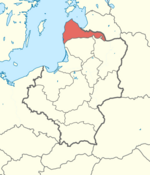
|

|
East Prussia | Prusy Wschodnie (Polish)
Rytų Prūsija (Lithuanian) |
Lithuania | 2,107,580 | Karaliaučius (Królewiec) |
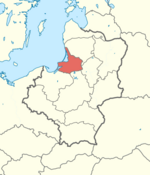
|

|
Greater Poland | Wielkopolska (Polish)
Didesnis Lenkija (Lithuanian) |
Poland | 7,796,532 | Poznań (Poznanė) |

|

|
Greater Lithuania | Wielkolitwa (Polish)
Aukštaitija (Lithuanian) |
Lithuania | 5,098,295 | Vilnius (Wilno) |

|

|
Lesser Poland | Małopolska (Polish)
Mažesnė Lenkija (Lithuanian) |
Poland | 5,494,010 | Kraków (Krokuva) |
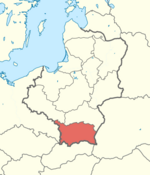
|

|
Lublin | Lublin (Polish)
Liublinas (Lithuanian) |
Poland | 4,567,048 | Lublin (Liublinas) |

|

|
Masovia | Mazowsze (Polish)
Mazovija (Lithuanian) |
Poland | 3,496,459 | Warszawa (Varšuva) |
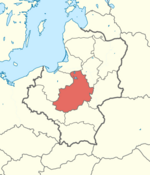
|

|
Pomerelia | Pomorze (Polish)
Pomeranijos (Lithuanian) |
Poland | 5,067,216 | Gdańsk (Gdanskas) |

|

|
Ruthenia | Ruś (Polish)
Rutenija (Lithuanian) |
Poland | 3,018,939 | Brześć-Litewski (Brestas-Litovskas) |
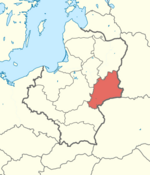
|
| File:Flag of Western Lithuania.svg | Western Lithuania | Zachodnia Litwa (Polish)
Vakarietiška Lietuvia (Lithuanian) |
Lithuania | 2,652,158 | Kaunas (Kowno) |
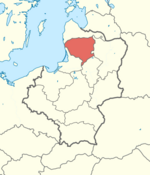
|
Each of the eleven voivodeships of Poland-Lithuania are then subsequently divided into counties (called powiats in Poland and apskritys in Lithuania). These counties function slightly differently in both Poland and Lithuania, although generally serve as the smallest functional district of government within the country. These counties exist either as regional district counties or as municipal counties (often shortened to 'districts' and 'cities' respectively), giving cities of a large population special administrative status. Approximately 400 counties exist within Poland-Lithuania, which are each then further subdivided into a third level of administrative division usually termed communes in English. In Lithuania, these communes are known as elderships (seniūnijos) and function not as centers of government but rather as regional social centers. The elected elder has very little political power, but is responsible largely for the maintenance of the local community and generation of regional initiatives in smaller areas, particularly in the rural countryside. In Poland, these communes are called gminas and do not serve the communal role of the elderships of Lithuania, rather acting as centers for local government and city councils. The gminas are less important in regional communities and more important in large cities, such as Warsaw and Gdańsk, where they form administrative councils subordinate to the larger municipal county of that city.
Lithuanian Separatist Movement
- Main Article: Lithuanian Separatist Movement.
A major issue within the politics of Poland-Lithuania throughout the past few years has been that of Lithuanian independence. Since the official end of the Polish-Lithuanian Commonwealth at the Congress of Vienna in 1815, Lithuanian nationalists have sought to create an independent Lithuanian state. As nationalist movements throughout Europe grew during the mid to late 19th century, many among the Lithuanian intelligentsia came to believe that political movement away from Poland would serve to benefit Lithuanian interests, largely as a result of the increasing dominance of Polish culture and language ubiquitous in nearly all aspects of everyday life. These desires for independence where championed by early Lithuanian nationalists and political thinkers such as Vytautas Kairys (1881-1942), Mikalojus Andrulis (1873-1951), and Markas Liepa (1806-1885), whose collective works, including Kairys' highly influential The Death of a Nation (1915), helped push the collective Lithuanian psyche towards one of independence. However, despite the growing momentum of the Lithuanian nationalist movement in the early 20th century, the rise of Piłsudski and subsequent dictators first under Nazi Germany and then the Soviet Union saw the brutal repression of such sentiments.
During the 20th century, as collectivism was enforced under communist ideology, a general Polish-Lithuanian national identity began to cement itself in the psyche of the general population. Among several nationalist minority groups however, the desire for Lithuanian independence remained strong. The collapse of Communism in Poland-Lithuania with the Revolutions of 1989 saw the attempts of a number of violent nationalist individuals, including the infamous political activist and later leader of the Miško Broliai Izaokas Dirgėla, to establish an independent Lithuanian state. Since this initial failure, numerous political referendums have been held which have all lost in favour of remaining in a political union with Poland, which many see as being both politically and economically advantageous to the Lithuanian state. Frustrated with what many deemed to be political stagnation, a number of increasingly militant and violent separatist groups have appeared within Poland-Lithuania throughout recent years, particularly under the presidency of the particularly pro-Polish Jacek Kaczerowski from 2006 to 2014. Among these groups are the infamous Miško Broliai, or 'Forest Brothers', the NLK, and the highly violent terrorist organisation the Knights of Mindaugas, who recently captured the media's attention through the organisation of the 2018 Karaliaučius bombing, which saw the deaths of some 24 people. These groups, which are generally extremist in nature and consist of small followings, have increased exponentially in size and strength over the past two years and remain a growing problem within the politics of Poland-Lithuania, particularly in the upcoming instability of the 2019 Polish-Lithuanian presidential election.
Foreign Relations
- Main Article: Foreign Relations of Poland-Lithuania.
Poland-Lithuania is a member of both the European Union and the Intermarium Alliance, the two most important international unions within Europe, and has seen a steady increase in its level of involvement internationally since the end of Communism in 1989. In particular, Poland-Lithuania's unique role as the leader of the Intermarium Alliance has seen it become a dominant regional political and economic power in Eastern Europe, where its relations with other IA member and prospective states have remained highly amicable since the introduction of the union in 1994. This, coupled with Poland-Lithuania's diplomatic efforts oversees (particularly in developing states and other formerly communist countries), has led to the formation of largely amicable relations with much of Europe and elsewhere internationally on the part of Poland-Lithuania. Poland-Lithuania is also a member of NATO, the League of Nations, the World Trade Organisation, the Organisation for Economic Co-Operation and Development (OECD), European Space Agency, Schengen Agreement, Kovac-Mieszko Area, G6, Council of Europe, Viségrad Group, and Council of the Baltic Sea States.
Following the Revolutions of 1989 in which Poland-Lithuania seceded from the Soviet Union, the country attempted to greatly increase its economic and political ties with the West, particularly with anglo-america and the Conference of American States. Massed immigration of Poles to America and Western Europe, particularly Sierra and France, combined with active investment in the Polish-Lithuanian economy and mutual co-operation in international affairs has meant that Poland-Lithuania's strongest diplomatic bonds today are with key Western economies, including Sierra, Brazoria, the United Commonwealth, France, the United Kingdom, and Germany. Within Europe, Poland-Lithuania has seen itself develop strong relationships with many formerly communist states, particularly Ukraine in the wake of the annexation of Crimea by the Russian Federation. In Asia and Oceania, Poland-Lithuania retains relatively good relations and economic ties with China, Japan, and the various Australian states (particularly Victoria and New South Wales, which have the largest population of ethnic Poles in the Asia-Pacific region), all of which provide mutual trading agreements and business with Poland-Lithuania. Relations with the Russian Federation since Poland-Lithuania's secession have remained somewhat tense, particularly following the formation of the Intermarium Alliance and increased threat to Russian hegemony in Eastern Europe posed by Poland-Lithuania. In general, a diplomatic crisis of kinds between Poland-Lithuania and the Russian Federation has slowly been developing through a number of political antagonisms played by both countries against one another, made only worst by recent discoveries of Russian espionage within prominent Polish-Lithuanian organisations. The fate of this antagonism however, remains unclear, and is one of the most controversial aspects of Polish-Lithuanian foreign relations in the 21st century.

Internationally, Poland-Lithuania has seen a moderate level of involvement in foreign aid and foreign war involvement. Polish-Lithuanian troops serving in the Central Armed Forces of the Intermarium Alliance (or CAFIA) have been sent to various major conflicts in the Middle East in the wake of the revolutions and civil wars of the Arab Spring, particularly in Syria and earlier Afghanistan, largely not as a result of any staunch desire by the Polish-Lithuanian government to be involved in these conflicts but rather as an effort to support Poland-Lithuania's more economically and politically influential allies, particularly CAS and NATO member states. In Europe, Poland-Lithuania has been a political advocate against Russia in many conflicts, particularly in aforementioned Ukraine as well as Georgia during the Russo-Georgian War of 2008, as well as being against the Belorussian anti-Polish ethnic campaign sponsored by Alexander Lukashenko and escalations of the Kosovo conflicts.
Today, Poland-Lithuania remains an important regional power within Eastern Europe and is of growing political and diplomatic importance in the broader European and international scene. Having faced some criticism for its political response to Lithuanian separatist terrorism and the broader issues of migration and terrorism in Europe, Poland-Lithuania nevertheless has continued to maintain a growing economy and generally positive diplomatic relations with most countries, with its growing economy and influence within Europe providing opportunity for further diplomatic missions and cultural expansion in the globalised world of the 21st century.

Military
- Main Article: Military of Poland-Lithuania. See Also: Collective Armed Forces of the Intermarium Alliance.
The military forces of Poland-Lithuania consists of four branches of organisation - the Polish-Lithuanian Land Forces (Polsko-Litewskie Siły Lądowe/Lenkijos ir Lietuvos Sausumos Pajėgos), Polish-Lithuanian Navy (Polsko-Litewska Marynarka Wojenna/Lenkų ir Lietuviškų Laivynų), Polish-Lithuanian Airforce (Polsko-Litewska Lotnictwo/Lenkų ir Lietuvių Oro Pajėgos), and Polish-Lithuanian Special Armed Forces (Polsko-Litewskie Specjalne Siły Zbrojne/Lenkijos ir Lietuvos Specialiosios Ginkluotosios Pajėgos, or 'PLSSZ'). Collectively, these forces number around 187,525 (including both active and reserve personnel) with an average government expenditure of $28.3 billion per annum on ongoing military upkeep. Poland-Lithuania's military is the 14th largest in Europe (larger than Austria's but smaller than Romania's) and 3rd largest in the Intermarium Alliance (after Belarus with 444,850 and Romania with 199,200 personnel). Although a relatively small military by European standards, Poland-Lithuania continues to maintain a strong military presence, particularly in Eastern Europe.

Military spending in Poland-Lithuania has gradually increased throughout the past few decades, particularly as a result of renewed aggression by the Russian Federation as seen in the Ukrainian crisis. As a result, the collective efforts and military resources of the Collective Armed Forces of the Intermarium Alliance (or CAFIA), that being the military branch of the Intermarium Alliance has become a priority among the Ministries of Defence of the various IA member states. Currently, CAFIA possesses a combined military force of 1,113,835 personnel, making it the 13th largest military force internationally. Military exercises by both the domestic Polish-Lithuanian Armed Forces, as well as CAFIA and combined European Union or NATO forces, occur frequently in the country, usually as training in preparation for the larger-scale military involvements of Poland-Lithuania internationally.
Generally, Poland-Lithuania's military force is largely involved in routine patrols and rescue missions in the Baltic Sea, particularly its navy and airforce. At a fundamental level, the Armed Forces are expected to function with the supreme purpose of defending Polish-Lithuanian territorial claims, however, due to the relative peace in which Eastern Europe currently finds itself the military has been largely employed in other international military efforts. Poland-Lithuania has supported many NATO-led international conflicts, particularly in the Middle East, where it has largely provided logistic or small unit support. In recent years, the Polish-Lithuanian military has become more involved in the preservation of public order in many major Lithuanian cities home to major separatist terrorist groups, including most notably Karaliaučius after its bombing in 2018. The Armed Forces are led by the Polish-Lithuanian Ministry for Defence, which is itself headed by the Minister of Defence (currently Bartosz Kazimierczak) and the presidential commander-in-chief. At the 2018 Prague IA Summit, a collective agreement among IA member states saw the promise of the Rześny regime to increase military spending and resource allocation to facilitate an active military of 280,000 personnel by 2030 in response to increased aggression from Russia. Concurrently, the Polish-Lithuanian military is undergoing a process of significant modernisation and technological upgrade that is expected to provide its servicemen with significantly better equipment and vessels to make the army more efficient by 2022.
Economy
- Main Article: Economy of Poland-Lithuania.
The collapse of Communism in Poland-Lithuania with the Revolutions of 1989 saw a rapid change from a centrally-planed to a free market capitalist economy with profound success for the economic performance of the country. As one of the most resilient eastern European economies, Poland-Lithuania has the fastest growing economy in Europe owing to its strong domestic and international market, low debt and unemployment, and lack of dependence on a single economic sector - a combination of economic factors which saw Poland-Lithuania remain the only state in Europe not to suffer the 2008 financial crisis. With major industries in agriculture, machinery, furniture, clothing, shoes, cosmetics, chemicals, and minerals, Poland-Lithuania's open and mixed economic system has ranked it as one of the highest growing and most successful formerly-communist economies, largely a result of the economic reforms of the Polish-Lithuanian government under the advise of Leszek Balcerowicz. Poland-Lithuania is part of the EU single market and Schengen area, as well as the Intermarium economic zone and Kovac-Mieszko area, uses the Polish-Lithuanian złoty (PLZ, using the symbol zł and divided into 100 grosz), and has its economic and financial hub based largely in the national capital of Warsaw, with significant industry in Vilnius, Karaliaučius, and Gdańsk.
Services, industry, and agriculture make up the three largest industrial sectors in Poland-Lithuania respectively, with the country being responsible for the production of many aforementioned goods that are then exported internationally, primarily to Germany, the Czech Republic, the United Kingdom, France, and Italy. The Polish-Lithuanian banking sector itself is the largest in central and eastern Europe, and forms one of the most competitive and highly developed market sectors within the country as a result of post-communist market incentives and economic policy. The National Bank of Poland-Lithuania, as well as a number of privately invested and foreign-owned banks, forms the largest and most prolific banking institution in the country. Foreign direct investment (or FDI) into Poland-Lithuania has also increased drastically since the country's abolition of communism in 1989, particularly from other Baltic states and members of CAS, including Sierra, Brazoria, and the United Commonwealth.

Following Poland-Lithuania's integration into the European Union beginning in 2004, massed emigration of both Poles and Lithuanians to the West in search of better employment opportunities and income saw a drastic demographic shift in the country that would ultimately result in an increase to general wages and a decrease in unemployment, changes which today have continued to slow emigration from Poland-Lithuania as it further develops economically. Today, Poland-Lithuania's economic growth has seen an increase in foreign investment and re-migration, as the country continues to be one of Eastern Europe's largest and most successful open market economies.
Corporations
Poland-Lithuania is an economic middle power in Europe and forms the largest economy in formerly Soviet Eastern Europe (outside of the Russian Federation). Nearly 40% of the top 500 best performing companies in central-eastern Europe are based in Poland-Lithuania, most of which are listed and traded in the Warsaw Stock Exchange's WIG30 index. Companies in Poland-Lithuania also have a high rate of globalisation comparative to other states in Europe, a trend matched by increases to foreign investment into Polish-Lithuanian businesses and externally by Polish-Lithuanian companies. The Warsaw Stock Exchange, which forms the key stock trading market within Poland-Lithuania, forms the largest exchange by market capitalisation in Central-Eastern Europe with over 1,346 trillion złoty (some 319 billion Euro).
Some internationally well known Polish-Lithuanian brands and companies include the National Bank of Poland-Lithuania, PKN Orlen, the Tauron Group, Plus, Air Polska-Litwa, Maxima PL, Polish-Lithuanian State Railways, and Telewizja Polska-Litwa (TPL). The ten largest companies by revenue within Poland-Lithuania are listed below:
| Rank | Logo | Corporation | Sector | Headquarters | Revenue (millions złoty) | Employees |
|---|---|---|---|---|---|---|

|
PKN Orlen | Oil and gas | Płock, Masovia, Poland (Lithuanian operations based in Mažeikiai, Western Lithuania) |
13,891 | 12,230 | |
| PGNiG | Oil and gas | Gdańsk, Pomerelia, Poland | 33,196 | 25,271 | ||
| PGE SA | Energy | Warsaw, Masovia, Poland | 28,092 | 44,317 | ||
| PZU SA | Insurance | Warsaw, Masovia, Poland | 22,212 | 36,419 | ||
| Grupta Lotos SA | Oil and gas | Gdańsk, Pomerelia, Poland | 20,931 | 33,071 | ||
| KGHM Polska-Litwa SA | Mining | Lublin, Lublin, Poland | 19,556 | 18,578 | ||
| Tauron Group SA | Energy | Kraków, Lesser Poland, Poland | 17,646 | 26,710 | ||
| PKO BP | Banking | Warsaw, Masovia, Poland | 13,544 | 29,441 | ||
| Enea SA | Energy | Poznań, Greater Poland, Poland | 11,255 | 23,805 | ||
| Maxima PL | Retail | Vilnius, Greater Lithuania, Lithuania | 8,456 | 17,071 |
Tourism
- Main Article: Tourism in Poland-Lithuania.
Throughout the past decade and especially since its entry into the European Union, Poland-Lithuania has seen a dramatic increase in its overall tourist influx, with the collective GDP contribution and number of international tourists per annum rising from 13.5 million in 2012 to 17.5 million in 2016. As a growing economic sector, tourism has seen increased importance and development in recent years as numbers of tourists continue to rise, a trend further accentuated by the relative dependence of the service market on a significant tourist consumer population. Of the tourists that visit Poland-Lithuania, the vast majority come from Germany (some 1.8 million in 2014), the United Kingdom, Russia, Ukraine, Belarus, and Sierra.
Tourists come to Poland-Lithuania for a number of different reasons, including ecological tourism to places such as Białowieża Forest in Ruthenia, northern Poland's various lake districts, or the Baltic coast; historical tourism in Poland-Lithuania's many important cities and historical landmarks; and sporting tourism (particularly in winter) to the Baltic sea and Carpathian mountains. Poland's lake districts in Kashubia and northern Masuria form one of the most visited natural landscapes in Poland-Lithuania, famed for their beauty and water sports internationally, as are the Carpathian mountains and High Tatras in the south. The most visited city in Poland-Lithuania is Kraków in Lesser Poland, whose historical role as the country's royal capital during the Polish-Lithuanian Golden Age saw the construction of a popular medieval town center and numerous castles and cathedrals. Similarly, other major cities such as Warsaw (with its restored medieval town center), Vilnius, Karaliaučius, Gdańsk, Toruń, Poznań, Lublin, Kaunas, Trakai, and Klaipėda are visited for their historical and cultural sites.
Religious pilgrimages also form an important part of the Polish-Lithuanian tourism industry, particularly by Christians to important centers for Catholicism in Licheń Stary and Jasna Góra and by Jews exploring the historical Shtetl areas of the Pale of Settlement in Poland-Lithuania's far east and the remains of Holocaust concentration camps such as Auschwitz-Birkenau. Snow sports in the country's various southern mountain districts, including Mount Rysy and Orla Perć, are also very popular and attract a large number of tourists to the country each year. Castles, museums, and other natural and historical sites (including 19 UNESCO World Heritage sites) found throughout Poland and Lithuania collectively attract further visitors and contribute to the wider Polish-Lithuanian economy.
The Curonian Spit in East Prussia, on the coast of the Baltic Sea.
A reconstructed Shtetl in Radziłów, Alytus-Podlachia.
The entrance to the Auschwitz Concentration Camp.
The waterfront in Gdańsk, an important Baltic city.
The Masurian Lake District in northern Poland.
The old town of Karaliaučius in East Prussia.
A Christmas market in the old market in Kraków.
The old town center of Kraków.
Wawel Castle in Kraków.
Another photo of Wawel Castle.
Malbork Castle in northern Poland, the former headquarters of the Teutonic Knights.
Snowboarding in the High Tatras of southern Poland.
Another photo of Toruń, whose old town is a UNESCO world heritage site.
The house of Nicholas Copernicus in Toruń.
Trakai Castle in central Lithuania, where the historic Oath of Trakai Castle was made.
Hot air ballooning is a popular tourist attraction in Vilnius.
The old town of Zamość, another UNESCO world heritage site.
Energy
- Main Article: Energy in Poland-Lithuania. See Also: Renewable Energy in Poland-Lithuania.
The vast majority of Poland-Lithuania's energy needs are supplied by locally produced and imported fossil-fuels, including coal. Natural gas reserves found in Poland-Lithuania and the Baltic Sea in combination with the country's extensive coal deposits in its south-west form the two principle energy sources and are dominated by Poland-Lithuania's largest companies, including PKN Orlen (Poland-Lithuania's only Fortune 500 listed company), the Tauron Group, PGE, and Enea. In the past, and particularly under Communism, nuclear energy formed one of the largest sources of energy within Poland-Lithuania, however, with the closing of Lithuania's Ignalina Nuclear Power Plant (the country's largest nuclear power generator) in 2009, energy production has been outsourced to foreign exporters and to other energy sources. In particular, Poland-Lithuania, as with much of continental Europe, is dependent on natural gas sourced in the Russian Federation, a dependency which has given Russia a significant political and economic advantage over Poland-Lithuania in the wake of the formation of the Intermarium Alliance.
Renewable energy sources account for a small but growing percentage of net energy production within Poland-Lithuania, and are sourced largely by hydroelectric dams (the largest of which is in Kaunas) and wind power. Recent renewable energy targets published under the Rześny administration aim to increase the renewable energy sector to 20% of total energy production in Poland-Lithuania by 2022. As part of this ambition, a number of new hydroelectric and wind power stations are being constructed throughout the country, particularly the large-scale Vistula Hydroelectric Scheme, which aims to provide some 340 gigawatt-hours to Polish-Lithuanian citizens as clean energy. Poland-Lithuania is also considering serious plans for the reconstruction of the eastern Lithuanian Ignalina Nuclear Power Plant in accordance with new European Union regulations, which would further increase the electricity output of domestic Polish-Lithuanian energy companies and reduce dependency on Russia and other foreign powers.

Transport
- Main Article: Transport in Poland-Lithuania. See Also: Train System of Poland-Lithuania, Air Polska-Litwa, and List of Highways in Poland-Lithuania.
As a large, centrally located country within central and eastern Europe, Poland-Lithuania maintains a large transport system that is well connected to other parts of Europe and the Schengen area which the country is part of. The railway system in Poland-Lithuania is one of the oldest in Europe, beginning with the construction of the Warsaw-St. Petersburg Railway in the middle of the 19th century, and is managed by the Polish-Lithuanian State Railways (Polsko-Litewskie Koleje Państwowe, or 'PLKL'), a partially-state owned transport industry which is responsible for the management and maintenance of Poland-Lithuania's railway network. Individual trains are operated by the various subsidiaries of PLKL, some of which are mostly privately owned, each of which are generally limited to a particular function or regional area, of which the largest include POLREGIO (regional Poland), Rail Baltica (Baltic coast), and Lithuanian Rail. The Polish-Lithuanian railway system is the the 3rd largest in Europe Poland-Lithuania with over 20,000km of railway, most of which is concentrated in northern and southern Poland, and consists of two rapid transport systems (Warsaw and Vilnius) connected by an expansive regional train network. Plans under the Rześny administration to connect all Polish-Lithuanian cities to a high speed rail system by 2020 have also been announced, as the government continues to invest in high speed railway and greater transport interconnectivity.
Road transport in Poland-Lithuania is undergoing a large-scale process of modernisation and upgrading, with the intent to rebuild and surface 80% of the country's roads by 2022. Highways connect the largest cities in Poland-Lithuania with other countries in the European Union and are maintained by the Polish-Lithuanian Road Transport Authority (Polsko-Litewski Urząd Transportu Drogowego, or 'PLUTD'). These highways provide the principle means of transport for trucks in Poland-Lithuania, which themselves form the largest means by which the transport and freighting industry is facilitated. The Polish-Lithuanian trucking network is one of the largest and most internationally widespread in Europe, connecting various places outside of Poland-Lithuania and providing a significant percentage of the total GDP contribution of the transport industry in the country.
Maritime transport via the Baltic Sea also forms an important part of the transport industry in Poland-Lithuania, with four of the Baltic Sea's ten largest ports by container turnover being found in the country (Gdańsk as 2nd largest, Gdynia as 4th, Klaipėda as 8th, and Karaliaučius as 10th). Plans to significantly expand the ports of Karaliaučius and Klaipėda have also been announced by the Polish-Lithuanian government, with the hopes of further increasing the economic performance of Poland-Lithuania in terms of maritime transport. Poland-Lithuania's national airline is Air Polska-Litwa (or APL), which is based in the country's largest international airport - Fryderyk Chopin International Airport in Warsaw. Air Polska-Litwa forms one of the oldest and most internationally connected airlines in Europe, with a fleet of 80 planes and over 100 destinations. Poland-Lithuania's largest international airports outside of Warsaw are John Paul II International Airport Kraków–Balice, Gdańsk Józef Kaszak International Airpot, Vilnius International Airport, Kaunas International Airport, and Karaliaučius International Airport.
Science and Technology
- Main Article: Polish-Lithuanian People § Science and Technology.
Poland-Lithuania has a long and well-established history of producing advancements in science and technology, beginning with the establishment of the universities of Kraków (Jagiełłonian University) and Vilnius in 1364 and 1579 respectively. The relatively liberal religious and political policies of the monarchs of the Polish-Lithuanian Commonwealth attracted many key scientific figures to Poland-Lithuania's major universities and scientific institutions during the Middle Ages, with the emergence of key scientific figures such as Nicolaus Copernicus (Mikołaj Kopernik), a discoverer and later proponent of heliocentricism as opposed to the Earth being at the center of the solar system, and Kazimieras Simonavičius, a pioneer of early rocketry and engineering.
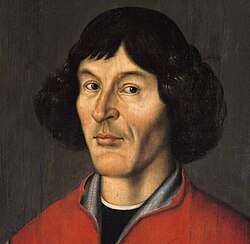
Following the Scientific Revolution, as Poland-Lithuania entered a period of increased political instability and insecurity, many Polish-Lithuanian born scientists and cultural figures moved overseas to continue their work. This population of native Polish-Lithuanians that would contribute to science outside of their home countries includes Marie Curie (born Maria Skłodowska), a Chemist and discoverer of radioactivity, who despite spending much of her life in France, continued to contribute to academic life in Poland-Lithuania with the creation of the Radium Institute and other similar scientific organisations. In the 20th century, the establishment of the Lwów School of Mathematics (now in Ukraine) and Warsaw School of Mathematics saw a substantial increase in the mathematical output of Polish-Lithuanian scientific and technological institutions, matched by scientific developments by scientists such as ophthalmologist Ludwik Zamenhof, anthropologist Bronisław Malinowski, pioneering endocrinologist Napoleon Cybulski, explorer and geographer Paweł Edmund Strzelecki, cryptographer and breaker of the Enigma code Marian Rejewski, virologist and inventor of the first live polio vaccine Hilary Koprowski, astronomer Aleksander Wolszczan, environmentalist Birutė Galdikas, and mathematician Jonas Kubilius.
Over 60 academic research and development institutions are currently operative in Poland-Lithuania, including some of the oldest universities in Europe, making Poland-Lithuania the biggest research and development hub in central-eastern Europe. Multinational companies and research organisations have set up development facilities in Poland-Lithuania, seeing its high availability of skilled workers and growing scientific scene as attractive and conducive to technological development. Poland-Lithuania is a leader internationally for research into light and laser physics, particularly at the University of Vilnius, as well as medical science with contributions to the invention of key biological editing devices such as CRISPR-Cas9 and diagnostic tools. A number of Polish-Lithuanian satellites have been launched into space, as have three ethnically Polish-Lithuanian astronauts (Mirosław Hermaszewski, Zenon Jankowski, and Rimantas Stankevičius). Poland-Lithuania has been home to 15 Nobel Prize laureates, the 9th highest number in Europe and 13th highest in the world.
Communications

- Main Article: Telecommunications in Poland-Lithuania.
Poland-Lithuania has well developed telecommunications infrastructure that connects its near 45 million residents through post, internet, and phone services. The Polish-Lithuanian post system (Poczta Polska-Litwa) has been in near-continuous operation since its inception under King Sigismund II Augustus in 1558, and continues to provide postal services to Polish-Lithuanian residents throughout the country. Provision of mobile phone services as opposed to fixed landlines have been increasing significantly throughout the past few decades as nation-wide 4G networks and greater accessibility to telecommunications and media reduce the need for fixed phones. Poland-Lithuania is known for having one of the fastest internet speeds in the world, higher than many other western nations traditionally higher-scoring than Poland-Lithuania in terms of scientific achievement, including the various CAS and Australian states.
Television and radio broadcasting in Poland-Lithuania requires a government purchased license, with a significant number of television and radio channels being privately owned. The largest television media company is Telewizja Polska-Litwa (TPL), with other major broadcasting institutions including Prawda Media SA (PRM), the Intermarium Broadcasting Corporation (IBC), and the exclusively Lithuanian-language Lithuanian Broadcasting Corporation (Lietuvos Transliavimo Korporacija, or LTK). Radio and newspaper still remain popular means of communication within Poland-Lithuania, with Radio TPL, Czas! Polska-Litwa, and PLRR being the largest and most wide-spread broadcasters.
Demographics
- Main Article: Demographics of Poland-Lithuania. See Also: Polish-Lithuanian Diaspora.
Poland-Lithuania has a population of 44,914,730, giving it the 8th largest population in Europe (after Spain but above Ukraine), largest in the Intermarium Alliance, and 32nd largest in the world (after Argentina but above Algeria). With a population density of 105.78 people per square kilometer, Poland-Lithuania has been experiencing a relative decline in population due to low birth rates and massed emigration in search of better financial opportunities following the collapse of Communism in 1989. Although rates of international exodus from the country have slowed, Poland-Lithuania's demographic landscape has dramatically shifted with its various political changes throughout the past century, with catastrophic losses of life in both World Wars and under Communist dictatorial rule. Polish-Lithuanian diaspora, affectionately nicknamed 'Polonia' after the Latin name for Poland-Lithuania, numbers some 20-25 million and is found primarily in the various CAS and Australian states, the United Kingdom, Germany, Ukraine, and Canada. Recent improvements to working and living conditions in Poland-Lithuania have, however, seen a slow returning of ethnic Poles and Lithuanias to the country, primarily from neighbouring Ukraine, Belarus, Germany, and Russia. As Poland-Lithuania continues to develop economically hopes of its diaspora returning home remain high among Polish-Lithuanian politicians and demographic experts.
As a result of the country's geography and historically liberal ethnic policy, Poland-Lithuania is home to a wide variety of ethnic groups, of which the two largest are Poles (native to Poland) and Lithuanians (native to Lithuania). These two ethnic groups have their own distinct demographic identity, history, and contemporary issues, each of which are generally dealt with by the individual governments of both constituent countries respectively. Similarly, the respective languages of both peoples - Polish and Lithuanian - share official status and bilingualism is both common and encouraged by the Polish-Lithuanian government. The unique bi-ethnic and cultural division of Poland-Lithuania has resulted in a diverse and particular demographic landscape seen in few other places internationally, an identity which often acts as a source of pride for Polish-Lithuanian people, whose collective, as well as individual, ethnic identities form an integral part of Poland-Lithuania's demographic landscape.
Ethnic Groups
| Affiliation | % of Polish-Lithuanian population | |
|---|---|---|
| Polish-Lithuanians | 87 | |
| Poles | 82 | |
| Lithuanians | 5 | |
| Ruthenians | 5 | |
| Germans | 3 | |
| Russians | 3 | |
| Other/No Answer | 2 | |
| Total | 100 | |
- Main Articles: Polish-Lithuanian People and Ethnic Minorities in Poland-Lithuania.
Poland-Lithuania is populated by two major ethnic groups; the Poles, who are a West Slavic people native to Poland; and the Lithuanians, who are a Baltic people native to Lithuania. Both Polish and Lithuanian ethnic identities first began to appear and coalesce with the formation of the independent states of Mieszko I and Mindaugas in Poland and Lithuania respectively during the early Middle Ages. The formation of these early states would see the gradual association of the Polish and Lithuanian ethnic identity with their respective political body, and as such an amalgamation of previously separate tribal communities into a larger demographic being. By the formation of the bi-federal Polish-Lithuanian Commonwealth under the Union of Lublin in 1569, a unique Polish and Lithuanian identity had been established which, after centuries of political and cultural union under the Commonwealth and later states, would begin to coalesce into a singular Polish-Lithuanian national identity. The vast majority of Polish-Lithuanian people today consider themselves to have a dual identity - one of a general Poland-Lithuania, and one of either Polish or Lithuanian ancestry. With the exception of extreme Lithuanian separatist movements, friction between Polish and Lithuanian people is relatively minimal, apart from some disagreement on the status of Lithuanian as a bi-national language. Significant populations of Poles and Lithuanians may be found in both Lithuania and Poland respectively, and the Polish and Lithuanian populations are generally highly integrated with one another throughout the country.
Outside of the Polish and Lithuanian demographic majorities, significant minority populations of ethnic Ruthenians (a collective term for Eastern Slavic people, but generally referring to Ukrainians and Belorussians), Russians, Germans, Romani, and Jews also exist, as well as yet smaller groups of other Western Slavs, Romance peoples, and people of Asian or African descent. By far the largest ethnic minority is that of the Ruthenians, which account for slightly less than 5% of the national population (approximately 3 million people) and primarily inhabit the country's easternmost voivodeships of Ruthenia and Greater Lithuania. The status of the Ruthenian people and languages (principally Belorussian and Ukrainian) is one which has received reasonable attention in recent years, particularly in the Ruthenian voivodeship. Similarly, the East Prussian voivodeship of western Lithuania, which existed for much of its history as Prussia, is home to significant German and Russian minorities desiring increased minority sovereignty and language rights.
Major Cities
- Main Article: List of Settlements in Poland-Lithuania.
Poland-Lithuania remains a largely urbanised country with clear divisions between highly urbanised and populated areas and less developed rural areas. The country's largest city is its capital of Warsaw, with a population of 1,764,615 as of 2017, a population more than twice the amount of Poland-Lithuania's second most populous city, Kraków. Poland in general is far more urbanised than Lithuania, with 15 of the country's 20 largest cities (including the top three by population size) being located in Poland. Conversely, areas of far eastern and northern Lithuania, particularly the voivodeships of Courland-Semigallia and Ruthenia, are significantly less populated, with Courland-Semigallia's capital and largest city of Mitau having less than a fifth of the population of the next smallest voivodeship capital (Kaunas in Western Lithuania). Nevertheless, Poland-Lithuania maintains a demographic trend towards urban migration and continues to invest in infrastructure that better connects its various cities and urban populations.
Largest cities or towns in Poland-Lithuania
2017 Census | |||||||||
|---|---|---|---|---|---|---|---|---|---|
| Rank | Name | State | Pop. | Rank | Name | State | Pop. | ||
 Warsaw  Kraków |
1 | Warsaw | Masovia | 1,764,615 | 11 | Brześć-Litewski | Ruthenia | 318,709 |  Łódż  Vilnius |
| 2 | Kraków | Lesser Poland | 766,739 | 12 | Kaunas | Western Lithuania | 312,120 | ||
| 3 | Łódż | Greater Poland | 690,422 | 13 | Białystok | Masovia | 296,228 | ||
| 4 | Vilnius | Greater Lithuania | 574,221 | 14 | Gdynia | Pomerelia | 246,991 | ||
| 5 | Poznań | Greater Poland | 551,627 | 15 | Radom | Lublin | 215,021 | ||
| 6 | Gdańsk | Pomerelia | 460,427 | 16 | Toruń | Pomerelia | 202,521 | ||
| 7 | Karaliaučius | East Prussia | 447,548 | 17 | Kielce | Lublin | 197,794 | ||
| 8 | Gardinas | Alytus-Podlachia | 365,610 | 18 | Klaipeda | Western Lithuania | 192,397 | ||
| 9 | Bydgoszcz | Greater Poland | 353,938 | 19 | Rzeszów | Lesser Poland | 187,422 | ||
| 10 | Lublin | Lublin | 349,103 | 20 | Olsztyn | Pomerelia | 172,993 | ||
The skyline of Warsaw, the capital and largest city of Poland-Lithuania
The restored old town of Warsaw.
The Palace of Culture and Science in Warsaw.
The old town of Kraków.
Kraków, the former royal capital of the Polish-Lithuanian Commonwealth.
Łódż, the third largest city in Poland-Lithuania.
The Lithuanian capital of Vilnius.
The skyline of Vilnius.
A street in central Vilnius.
Poznań in Greater Poland.
The waterfront in Gdańsk, an important Baltic city.
The Kholm Gate in Brześć-Litewski, the capital of Ruthenia.
Kaunas, the capital of Western Lithuania.
Radom in southern Poland.
Another photo of Toruń, whose old town is a UNESCO world heritage site.
A castle in Kielce, southern Poland.
A hotel on the port in Klaipėda, Western Lithuania.
Rzeszów in Lesser Poland.
Languages
- Main Articles: Polish language, Lithuanian language, and Languages of Poland-Lithuania.
Poland-Lithuania has two official national languages - Polish and Lithuanian, and recognises five regional minority languages - German (primarily in East Prussia), Kashubian (in Pomerelia), Latvian (in Courland-Semigallia), Ukrainian (Ruthenia), and Belorussian (Ruthenia and Greater Lithuania). Polish is a Western Slavic Language (as is the minority language Kashubian) and is an official language only in Poland-Lithuania and the United Provinces (specifically the province of New Pomerelia, where significant populations of ethnic Polish-Lithuanians live). It uses the Latin alphabet with nine additional special characters (ą, ć, ę, ł, ń, ó, ś, ź, and ż) and, along with Lithuania, is one of the official languages of the European Union and the Intermarium Alliance. Lithuanian, contrasting Polish, is a Baltic language whose only living immediate relative is Latvian (also a minority language in Poland-Lithuania). Lithuanian also uses the Latin script with the addition of eight additional special characters (ą, č, ę, ė, į, š, ų, and ū).

Bilingualism within Poland-Lithuania is both strongly encouraged and commonplace, with many children either growing up in bilingual Polish-Lithuanian homes or learning either language in school. By law, all schools must offer either foreign language classes in the language of the opposite constituent country in which that school is located or regular classes entirely in that language (ie, Polish schools must offer classes in Lithuanian and vice versa). The vast majority of schools in Poland-Lithuania are entirely bilingual, with approximately half of their classes run in each language. Bilingualism is marginally more common in Lithuania than Poland, as Polish forms the demographically and culturally dominant language of Poland-Lithuania. A steady polonisation of the Lithuanian language has also occured over the past few centuries, as Lithuanian has adopted a number of grammatical and lexicographical features unique to its dominant partner Polish. Since the Revolutions of 1989 the teaching of Russian as the primary foreign language in schools has been replaced with English and to a lesser extent German, with other schools offering education in French, Spanish, and Italian as alternative foreign languages.
| Affiliation | % of population | |
|---|---|---|
| Christianity | 89 | |
| Catholicism | 85 | |
| Eastern Orthodox | 3.5 | |
| Protestantism | 0.5 | |
| Irreligious | 6 | |
| Other Faith | 3 | |
| Don't know/refused answer | 2 | |
| Total | 100 | |
In regions where significant ethnic minority populations exist (particularly in Ruthenia), schools offering instruction in that area's native language also exist. Efforts to maintain and preserve minority languages in Poland-Lithuania, particularly Kashubian and Ukrainian, exist through significant foreign language education programs and political activism throughout the country, and are often associated with efforts for greater minority sovereignty among these ethnic groups. Outside of Polish and Lithuanian, the most commonly spoken language in Poland-Lithuania is Belorussian (at approximately 3.5% of the population), followed by Ukrainian, Latvian and Russian (each at around 1%). Official government regional support is provided to areas in which these minority language communities exist, consisting of translation services, the legalisation of foreign-language schools, and financial support to fund the continued preservation of those languages.
Religion
- Main Article: Religion in Poland-Lithuania.
Since the Baptism of Poland under Mieszko I in 966 and subsequent christianisation of the native Polish people, Poland has maintained an extremely high rate of religious observance and Catholic faith. Similarly, following the adoption of Christianity in Lithuania in favour of native Lithuanian Paganism in 1387, Lithuania has maintained a strong Catholic identity which continues well into the present day. Almost 90% of the Polish-Lithuanian population identify themselves as Christian, with 85% of those Christians identifying as Catholic, giving Poland-Lithuania has the 7th highest total population percentage and 8th highest number of Catholics in the world. This saturation of Catholic religious culture and practice has been deeply ingrained into Polish-Lithuanian culture as one of the most devoutly Catholic regions of Europe, and maintains an integral part of everyday life in Poland-Lithuania into the 21st century.'
Besides having maintained a strong Catholic tradition, Poland-Lithuania has also traditionally been a region of high religious tolerance and diversity as a result of the Warsaw Confederation of 1573, which granted religious freedom to all religious minorities within the Polish-Lithuanian Commonwealth. As such, medieval Poland-Lithuania saw a high population of Jews, Orthodox Christians, and other non-Catholic religions which defined the region as one of relatively high liberty until the 20th century, where war and genocide significantly reduced the religious diversity of Eastern Europe. Today, Eastern Orthodoxy forms the largest non-Catholic Christian denomination, with some 3.5% of the population adhering to it (mostly being ethnic Ruthenians in the far east of Poland-Lithuania). Protestants and other faiths, including Judaism, Islam, Buddhism, and Neopaganism also form approximately 3.5% of the Polish-Lithuanian population.
Irreligiosity, as in many other European and Western nations, is increasing in Poland-Lithuania, with some 8% of the total population either not knowing or identifying as having no religion. This trend, coupled with reduced rates of practicing Christians, have alarmed some within the religious community of Poland-Lithuania as religious and political conservatism has left many former believers disenfranchised with the Polish-Lithuanian Christian institution. In a counter-Christian religious trend that has gained momentum over recent years, practitioners of Neopaganism, specifically Rodzimowierstwo in Poland and Lithuanian Paganism, have also been increasing. These religious few practice traditional Slavic and Baltic pagan beliefs as existed before the Christianisation of both states in the early Middle Ages, and aim to restore some of the patriotic and naturalistic traditions of these early faiths.
Religious tourism, specifically pilgrimage, also forms an important part of the Polish-Lithuanian economy, with Catholics and other Christians from all over Europe and elsewhere in the world travelling to Poland to visit its numerous religious sites. This trend was only further enhanced by the appointment of Karol Wojtyła as Pope John Paul II in 1978, whose encouragement of the Polish-Lithuanian people to "be not afraid" was instrumental in the collapse of Communism and subsequent movement towards Polish-Lithuanian democracy and Western integration in the late 20th century under Józef Kaszak and the Solidarity Workers' Union. Key sites of religious pilgrimage in Poland-Lithuania which support this tourism include the Monastery of Jasna Góra near Częstochowa in Lesser Poland, the Basilica of Our Lady of Licheń in Greater Poland, the family home of John Paul II, Grabarka-Klasztor, Hill of Crosses near Šiauliai in Western Lithuania, and the Church of St. Peter and St. Paul in Vilnius.

Health
- Main Article: Health in Poland-Lithuania.
Nation-wide free health care is provided across Poland-Lithuania with numerous private health organisations and insurance funds existing concurrently. A general health insurance system regulates the provision of public health care to eligible citizens of the country, however citizens are not required to be treated in state-run hospitals if a medical emergency occurs. All health care institutions, whether public of private, as well as insurance companies, must have approval and licenses by the Ministry of Health, which in addition to licensing medical practitioners and insurers also oversees the day-to-day management and administration of the healthcare system.
Poland-Lithuania was ranked 29th in the Euro Health Consumer Index of 2016, having better health care than Hungary but worse than Latvia. The average life expectancy at birth is 75.5 years (70.6 for infant males and 80.3 for infant females), with leading causes of death being heart disease, stroke, lung cancer, self harm, and road injury. Rates of suicide have increased dramatically since the end of Communist rule in Poland-Lithuania, largely as a result of reduced religiosity and belief in suicide as a sin. Population growth continues to accelerate in Poland-Lithuania despite the modern demographic crisis of massed migration out of Poland-Lithuania as work opportunities steadily improve. State hsopitals are required by law to exist in certain numbers within each voivodeship, although many contain many more than what is necessary at a minimum legal level. Medical research and developments continue to develop in Poland-Lithuania as the government under Krzysztof Rześny continues to invest substantial funds into research and scientific development.
Education
- Main Article: Education in Poland-Lithuania. See Also: Universities in Poland-Lithuania.
Education in Poland-Lithuania is compulsory and provided freely to Polish-Lithuanian citizens until the age of 18 in accordance with the country's constitution and law as resolved by the Ministry of Education. As part of the constitutional status of both Poland and Lithuania as being bi-federal political entities, the non-tertiary education system in both constitute countries varies, although any achieved diplomas or high school certificates obtained in one constituent country are recognised nationally. Across both Poland and Lithuania four key levels of education exist - pre-primary, primary, secondary (which is divided into two schools in Poland but not Lithuania), and tertiary, which is universal throughout the country. Pre-school education can begin at as early as one year of age and consists of kindergartens and pre-schools which provide care and basic education to its members. One year of compulsory preparatory pre-primary education is provided for free at the age of 6 (or 5 in exceptional circumstances) to prepare a child for entrance into Primary School. This is usually undertaken at a kindergarten and is called 'year zero' (zerówka or klasa 0/0 klasė), and may only be accelerated a year if the child is demonstrated to have exceptional intellectual maturity for his/her age.

Primary education begins at the age of 7 in both Poland and Lithuania at a Primary School (Polish: Szkoła Podstawowa, Lithuanian: Pradinė Mokykla), attendance of which is compulsory in both constituent states. In Poland, Primary School lasts until the age of 15 and is subdivided into two sub-schools - Pierwsza szkoła (first school), which consists of three years of general, integrated learning with a single teacher for all subjects; and Druga szkoła (second school), which consists of five years of subject-specific primary education. At the end of primary school in Poland, a competency test called the General Competency Test (Ogólny Test Kompetencji, or 'OTK') is undertaken, the passing of which allows a student to enter Junior High School (or the Gimnazjum). Contrasting this system, Primary School in Lithuania ends at the age of 11 and does not require a General Competency Test equivalent, nor is it divided into several sub-schools. A general focus on integrated studies and independent investigation is employed in Lithuanian Primary Schools, where as Polish Primary Schools adopt a more pedagogical and rigid approach to learning and subject creation.
Secondary Education varies significantly between both Poland and Lithuania, however general, non-vocational secondary schools throughout the country all offer courses in a national matriculation certificate - the Matura. In Poland, two separate tiers of secondary schools exist - Junior and Upper Secondary Schools - each of which may have different forms. The Junior High School (or Gimnazjum) is three years in length and acts as preparation for the Matura or vocational training. Completion of the Gimnazjum is compulsory, with any further qualifications or schooling not been required by the state. Students of the Gimnazjum must study Polish, Lithuanian, a foreign language, mathematics, physics, chemistry, biology, history, civics and economics, geography, fine arts, music, or theater studies, a technology subject (such as food technology, textiles, woodwork etc.), physical education, and religion or social studies. The student's grade scores are totaled and averaged over the last two years of the Gimnazjum to produce average scores in Polish, Lithuanian, Mathematics, Science, Arts and Technologies, and Humanities. These averaged scores are then used to determine whether or not a student is eligible for entry into an appropriate Upper Secondary School, which forms the next, non-compulsory element of Polish secondary education.

Three different forms of Upper Secondary Education exist within Poland which form the non-compulsory successor courses for students who have completed studies at a Gimnazjum. The first and most popular of these is the Liceum, in which students achieve a Matura national matriculation certificate over three years from 18 to 21. The Technikum school offers both vocational training and/or apprenticeships concurrently to the Matura diploma, allowing students four years to complete their secondary studies between 18 and 22. Finally, the Szkoła Wakacyjna offers vocational training without undertaking the Matura over two years between 18 and 20 years of age. Szkoła Wakacyjna, or 'Vocational Schools', also exist in Lithuania and form an alternative pathway for students wishing to enter vocational trades. Lithuanian vocational schools begin at 17 and end at 19 years of age, with students leaving mainstream Lithuanian Vidurinės Mokyklos (the equivalent to the Polish Gimnazjum) before the commencement of their Matura studies at 17 years of age. Unlike in Poland, only one mainstream Secondary School (apart from the Szkoła Wakazyjna) exists in Lithuania, the Vidurinės Mokyklos, which consists of eight years from the ages of 11 to 19. This means that Lithuanian students complete their final year of the Matura at 19 whereas Polish students complete it at 21 or 22, a significant age difference that provides a major distinction between the two countries.
Tertiary Education in Poland-Lithuania is based on Matura results, which is derived from the total study scores in the student's various subjects, weighting more heavily for key subjects such as Polish, Lithuanian, Mathematics, and another foreign language to give a total score out of 100. Over 500 tertiary level institutions exist within the country, of which roughly 30 are registered traditional universities. Of these, the oldest and most prestigious are the University of Kraków (Jagiełłonian University), the University of Karaliaučius (the Albertina), Vilnius University, Mickiewicz University Poznań, and the University of Warsaw. A number of specialist technical and arts universities also exist throughout the country. University education remains free at an undergraduate level or highly discounted for Polish-Lithuanian citizens, as are all public secondary and primary level educational institutions in both Poland and Lithuania. Private and religious schools, as well as ethnic minority schools in Ruthenia, Greater Lithuania, and Courland-Semigallia offer particular resources or educational opportunities otherwise limited in the state education system, however Poland-Lithuania continues to invest heavily into education and maintain a high standard of academic results and teaching practices.
Culture
| Part of a series on the |
| Culture of Poland-Lithuania |
|---|
 |
- Main Article: Culture of Poland-Lithuania.
As a result of Poland-Lithuania's unique bi-national historical identity, Polish-Lithuanian culture is itself derived from a wide variety of traditional cultural and historical sources. Maintaining a strong tradition of artistic sponsorship under the monarchs of the Polish-Lithuanian Commonwealth, Poland-Lithuania is world-renown for its contributions to a number of specific cultural mediums, particularly music through the works of a number of highly influential composers and musicians, such as Fryderyck Chopin, Artur Rubenstein, Krzysztof Penderecki, and Witold Lutosławski. The highly individual character of Polish-Lithuanian art has been shaped by its people, geography, and tragic history at the confluence of Western and Eastern European culture, with the ethnic, religious, and individual diversity of various groups and peoples throughout the country's history having a profound influence on its culture today.
Following the end of the Second World War, Poland-Lithuania saw a dramatic reduction in its cultural diversity and individual identity in favour of a more uniform Soviet identity under Kajetan Bąk and Joseph Stalin. The forced emigration of many once-celebrated Polish-Lithuanian minorities, including the Prussian Germans and Latvians, and enforced pan-Slavic cultural and political identity saw a repression of Polish-Lithuanian culture and language and the emigration of many artists and leading pre-war cultural figures. This repression has, however, had an unexpectedly positive effect on modern Polish-Lithuanian culture, in that many modern Polish-Lithuanian artists have used the repression of the past as a focal point for artistic expression. Poland-Lithuania's distinctly sorrowful history in the 20th century has, as with much of Eastern Europe, become an intrinsic part of its cultural identity.
Today, as Poland-Lithuania regains and revitalises its formerly proud diversity, it is experiencing a period of growing cultural enrichment, particularly when combined with increased exposure to and collaboration with the formerly disconnected West of Europe and America. Modern artists and cultural figures experience substantial support from the Polish-Lithuanian Ministry of Arts and Culture, which, under the leadership of Krzysztof Rześny and Dawydas Rozbicki has promised increased government spending on funding cultural and artistic developments within Poland-Lithuania.

Art
- Main Article: Art in Poland-Lithuania.
Art has continually played an important role in the expression of Polish-Lithuanian culture and, more broadly, its belonging within an overarching European environment. Historically, art in both Poland and Lithuania was largely sponsored by royal dynasties and large magnate families, resulting in the foundation of institutions such as the Kraków Academy of Fine Arts in Poland or the Vilnius School of Art in Lithuania, wherein many prominent artists created and developed a distinctly Polish-Lithuanian nationalist style. Artists of this type include Pranciškus Smuglevičius, Jan Matejko, Józef Oleszkiewicz, and Jan Rustem, among others.
Despite the significance of these early Polish-Lithuanian artists, however, it would not be until the emergence of the Young Poland-Lithuania movement (Młoda Polska-Litwa) at the end of the 19th century that Polish-Lithuanian art came to the attention of the world at large. This movement, led by the prominent painters Jacek Malczewski and Józef Mehoffer, saw a focus on formal experimentation across a wide array of art forms and the development of patriotic symbolism spurned on by a historical awareness of Polish and Lithuanian cultural vibrancy following the Polish-Lithuanian Revolution of 1848.
Music
- Main Article: Music in Poland-Lithuania.



